News & Notes
Categories
.jpg)
Professor Oliver Wunsch publishes article in Art History on Black subjects in French art
In the February issue of the journal Art History, Professor Wunsch examines how audiences in eighteenth-century France could admire Black people in art while denigrating them in life. He shows that they justified this contradiction through a belief in the ameliorating effects of art, adhering to what Wunsch describes as a theory of aesthetic redemption. Wunsch argues that the theory of aesthetic redemption that developed in eighteenth-century France gave art a unique position in the construction of race. Because those who believed in the possibility of aesthetic redemption distinguished between art’s content and its manner of representation, they created the conditions for artists to depict people of color using materials, techniques, and formal structures whose qualities would otherwise be considered at odds with the subject. The resulting art often strikes audiences today as progressive, yet it did little to challenge the biases of the original viewers, who admired aesthetic departures from stereotypes precisely because they took those stereotypes for granted.
.jpg)
Professor Stephanie C. Leone, publishes an article about the painting, "The Victory at San Pietro in Casale," in the Doria Pamphilj Gallery, Rome, in the February 2025 issue of The Burlington Magazine.
Using archival evidence and a closer reading of the primary sources, Professor Leone and co-author, Dr. Alessandro Serrani, have proposed a new understanding of the monumental painting in the Galleria Doria Pamphilj, Rome, which was formerly identified as the Battle of Castro and attributed to Jacques Courtois (known as il Borgognone; 1621–76) and Carlo Maratta (1625–1713). They have narrowed the location and chronology of the painting’s production to Bologna, between late August 1649 and February 1651, and identified the patron as papal vice legate Monsignor Marcello Santacroce (1619–1674), who donated it to his benefactor, Pope Innocent X Pamphilj (reg. 1644–55). In addition, rather than illustrating the battle at Castro that ended on 2nd September 1649, they argue that the painting in fact depicts a related occurrence at San Pietro in Casale on 13th August 1649. Consequently, given the date and the provenance of Bologna, Maratta and Borgognone cannot be the painters. Instead, based on style, they suggest that the Bolognese painter Giovanni Andrea Sirani (1610–70) was at least partially involved in the work’s execution.
February 2025 issue of The Burlington Magazine
Show More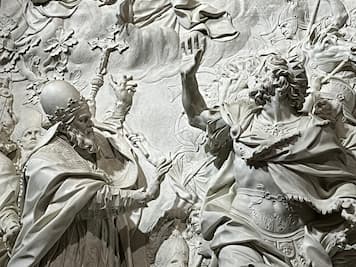
Stephanie C. Leone, Restoring Rome for the Jubilee: Pope Innocent X’s Motives, Methods, and Meaning in 1650 (Tuesday, 1 April 2025, 6pm, American Academy in Rome)
When Innocent X Pamphilj was elected pope in 1644, he quickly commissioned monumental works of architecture and sculpture at St. Peter’s and San Giovanni in Laterano, according to G.S. Ruggieri’s Diario dell’anno del SS.mo Giubileo 1650, “to excite greater devotion in pilgrims and foreigners…[and] reflect the piety, religion, and paternal affection of the Pope toward this Holy City, his homeland.” Ruggieri’s contemporary voice serves as a starting point to investigate Innocent X’s motivations for renovating Rome for the Jubilee, which also comprised projects at Piazza Navona and the Campidoglio. Through select examples, this paper explores why Innocent X—head of the Roman Catholic Church, protector of the Pamphilj family, and Roman citizen—chose these locations and what, specifically, he aimed to communicate to pilgrims and Romans alike. Furthermore, it argues that he accomplished so much artistic production in such little time—only five years—by harnessing the robust building and sculptural industries of Rome and employing proven and new operational strategies. Further information can be found here.
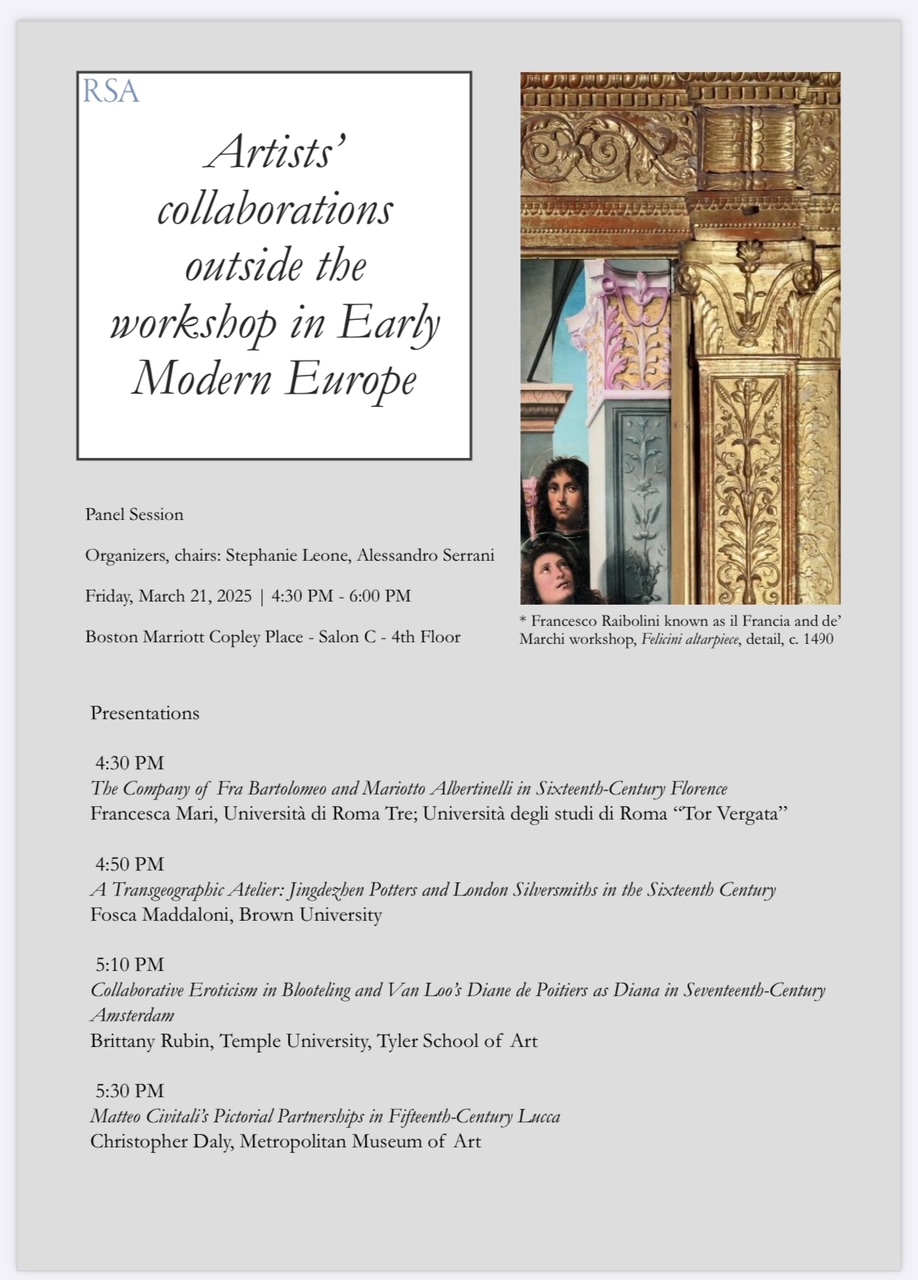
Renaissance Society of America Conference
Professor Stephanie Leone is participating in the Renaissance Society of America's conference, held in Boston, from 20-22 March 2025. She has co-organized and is co-chairing the panel, "Artists' Collaborations outside the Workshop in Early Modern Europe." Professor Leone is also chairing the panel, "Street Art in Early Modern Italy."

Embrangledscape
Embrangledscape at Williams Center Gallery at Lafayette College, in Easton,PA showcases the work of installation artist Debra Weisberg. The exhibition features densely collage works on paper along with two site specific installations, one in the performance lobby providing a portal ionto which Brazilian born choreographer Paula Gil Higa's dance video is projected. January 30- March 14, 2025

Stephanie Stigliano's Don't Judge a Book by its Cover
Don't Judge a Book by its Cover, Cultural Center of Cape Cod, 307 Old Main St.South Yarmouth, MA. Artist books by Stigliano included in this national juried exhibit. February 3–March 1, 2025; Friday, February 7th reception 5-7pm
https://www.cultural-center.org/dontjudgeabookbyitscover
Show More.jpg)
February Artist: Stephanie Stigliano, books and prints, Malden Public Library
February Artist: Stephanie Stigliano, books and prints, Malden Public Library36 Salem St. Malden, MA 9-9pm M-Th; 9-6 F-Sat. Closed Sundays.Monday, February 3rd reception 6-7pm
.jpg)
Amy Golahny: "Rembrandt's Artemesia Revisited"
In 2000 the author proposed that the regal woman in the painting by Rembrandt(1606–1669) in the Prado is Artemisia, queen of Caria in the fourth centuryBC, rather than Sophonisba, Carthaginian princess, as she has often been called (“Rembrandt’s ‘Artemisia’: Arts Patron,” Oud Holland, 114, 2/4, 2000, 139-52). Artemisia rules with Mausolos, her husband, and they built a monument to hold their ashes as a tomb; after his death she drinks a potion of his ashes daily, and commissions poetry in his honor. The present article brings additional support for Artemisia as the subject of the painting. Rembrandt would have read about Artemisia during his year at Leiden university, when his textbook contained essential details of her life. As Rembrandt included an enormous book to show her patronage of poetry in honor of her deceased husband, he would be followed by several Dutch painters in their versions of the story. This article further examines the early inventories that mention Rembrandt's painting, and the recent interpretations of it as representing Judith at the banquet of Holofernes or Esther.
.jpg)
CONSTITUENT PARTS: Cathy Della Lucia and Nicholas Anthony Mancini in Dialogue
Cathy Della Lucia’s modular sculptures merge hand-finished wood, 3D-printed silicone, ceramics, and found objects. Using traditional Japanese joinery, these interactive pieces unfold and reassemble, reflecting her diverse experiences as a sculptor, former athlete, Korean-American adoptee, and woman in the U.S.
Reception: January 30, 2025, 6-8PM @ 808 Gallery, Boston University
Show More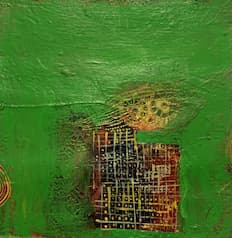
Khalid Kodi's Out of Place: Alternative Landsacapes and Other Stories
Skoto Gallery is pleased to present Out of Place: Alternative Landscapes and Other Stories, an exhibition of recent works by the Sudanese-born artist Khalid Kodi. This will be his third solo show at the gallery. The reception is on Thursday, January 30, 6-8pm. The artist will be present.artist will be present. Out of Place is a conceptual exploration of the dynamic interplay between nature and human perception. These alternative landscapes challenge traditional notions of place and expand the boundaries of how we perceive and interact with the environment. Through fluid forms, vibrant gestures, and abstracted terrains, the works invite us to step beyond the static imagery of landscapes and enter a world of endless possibilities—where nature is not merely observed but continuously rearranged, imagined, and co-created. This exhibition examines the moments when nature escapes definition. Here, nature is both static and mutable, an entity we encounter and rearrange—sometimes with intention, sometimes in unconscious gestures, and other times in states of playful disruption. “Out of Place” reflects a search for that which lies beyond the known—a place of desire, comfort, majesty, love, and even madness. It asks: What happens when we deconstruct landscapes? When we let our minds wander through imagined terrains? When we infuse our interactions with nature with elements of whimsy, chaos, and longing? The abstract compositions of Out of Place reject the rigidity of fixed landscapes. Instead, they propose an alternative: a fluid interplay of color, form, and movement. Swirling brushstrokes, scattered patterns, and unexpected juxtapositions evoke a sense of both familiarity and dislocation. These are not landscapes we know; they are landscapes we dream of, where natural forms and human interventions collide, merge, and transform. At its core, this collection is a meditation on the human tendency to shape and be shaped by the natural world. It celebrates the tension between control and surrender, order and chaos. In these works, we find a mirror of our own restless curiosity and our constant quest to reimagine the spaces we inhabit. Out of Place: Alternative Landscapes and Other Stories is an invitation to explore the profound interplay of perception, imagination, and the natural world. Through this exhibition, viewers are encouraged to reflect on their own relationship with landscapes—both the ones they know and the ones they yearn to create. Born in Sudan, Khalid Kodi is an accomplished artist who has lived and worked in the US since the early 1990s. He is an educator, a public intellectual, and a cultural critic who has emerged as a central figure working on multi/cross cultural concepts. A pioneer of Participatory Art, he uses visual language to address social change issues and facilitate communication between communities, including communities in conflict and individuals who are not literate. Kodi uses art as a mechanism to create a platform for dialogue on constructions of identity across racial, gender socio-economic, and other forms of difference, co-existence, justice and peace. His work has been widely exhibited with critical acclaim.
.jpg)
Stephanie Leone's "Cardinal Benedetto Pamphilj: Patron of the Villa del Gran Priorato, Rome (1678-1730)"
Professor Stephanie Leone has published an article about "Cardinal Benedetto Pamphilj: Patron of the Villa del Gran Priorato, Rome (1678-1730)," in L’Ordine di Malta e la Lingua d’Italia. Architettura e temi decorativi dalla Controriforma al Settecento, a special issue of the journal Lexicon, available here. Leone argues that the relationship between the Order of Malta and Benedetto Pamphilj--who served as Grand Prior of Rome from 1678 to 1730--was mutually beneficial. The exceptionally educated young nobleman blossomed into a consummate cardinal patron, who took seriously his stewardship of the Order and the villa del Gran Priorato. Her archival research shows that Cardinal Pamphilj sponsored major repairs to the Villa from 1689 to 1705. In 1704, he built a new garden pavilion that was designed and executed by Francesco Fontana and commissioned Luigi Garza to paint a fresco of the Ecce angus Dei, in the vault of this pavilion. Professor Leone demonstrates that the position of Grand Prior was the means through which Benedetto Pamphilj fulfilled the expectations of a cardinal-prince, at once wealthy secular aristocrat and pious apostolic successor.
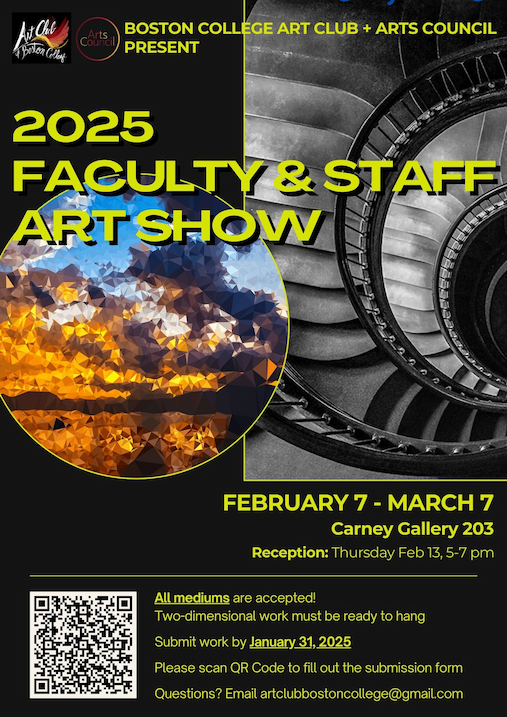
2025 Faculty & Staff Art Show
.jpg)
Pope Innocent X and Roma sancta
Prof. Stephanie Leone presented a paper on "Pope Innocent X and Roma sancta," at the Early Modern Rome 5 Conference, which was held in Rome and the Orsini-Odescalchi Castle on Lake Bracciano. Prof. Leone interpreted Algardi's magnificent altarpiece of Saint Leo the Great and Attila the Hun, in St. Peter's, as Innocent X's revival of early Christian Rome for the Holy Year of 1650.
.jpg)
The Art of Sammy Chong
Studio Art professor Sammy Chong's paintings are the subject of a recent essay by Vicente Chong, S.J. entitled "The Art of Sammy Chong as a Revelatory and Symbolic Meditation of a Servant God" in Theology and Media(tion): Rendering the Absent Present, edited by Stephen Okey and Katherin G. Schmidt (Orbis Books, Maryknoll, New York: 2024), 210-223.
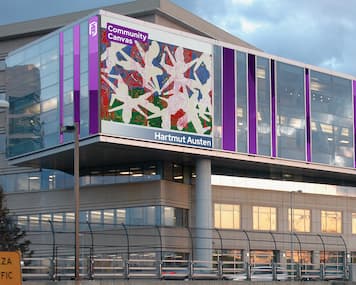
Hartmut Austen's Divide
Hartmut Austen's mural Divide was on display at WGBH on Thursday, November 14. Divide is an acrylic and oil painting loosely based on Matisse’s “La Danse”. The abstract shapes are derived from the blurry online image of a military “Global Hawk” drone in flight.“It’s an elegant shape, weirdly figurative, and when turned upside down, sculptural,” Austen says. “For me, the drone shapes became a vehicle that helped me reflect on the battles that this country has fought, and still is fighting - with others and with itself.”
%20.jpg)
Professor David Young Kim, Department of the History of Art at the University of Pennsylvania, presented the Annual Josephine von Henneberg Lecture in Italian Art.
On October 3, 2024, Professor David Young Kim, Department of the History of Art at the University of Pennsylvania, presented the Annual Josephine von Henneberg Lecture in Italian Art. He discussed his new research project, "Found in Translation: Giorgio Vasari in Korea," about the interdependence of image and word in art history, the intersecting biographies of artists, writers, and art historians, and questions of identity in contemporary scholarship. Faculty, students, and friends of Boston College and the Boston community filled the lecture room at the Ricci Institute for Chinese-Western Cultural History. This year's lecture was co-sponsored by the Ricci Institute and the Art, Art History and Film Department. The lecture series is made possible by the generous gift of Professor Emerita Josephine von Henneberg.
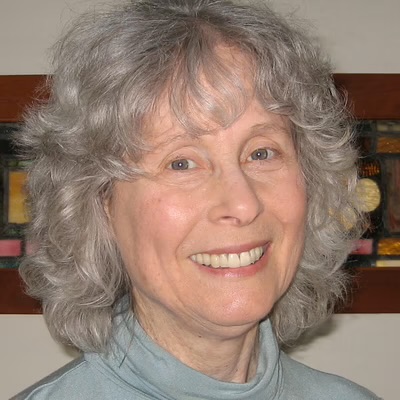
In Memoriam: Pamela Berger (1940-2024)
Our beloved colleague Pamela Berger (1940-2024) passed away on August 31st, 2024. Professor Berger joined our department in 1974, after receiving her PhD in art history at the Institute of Fine Arts, New York University. She retired in 2021, following nearly five decades at Boston College.
A renowned scholar of medieval art history, Professor Berger published a remarkable four books in her career, the most recent of which was Hebrew Psalms and the Utrecht Psalter: Veiled Origins, published in 2020. Much of her research engages iconography and iconology, analytical approaches she found particularly effective for understanding the meaning of a work of art in its own time. Pamela was also active as a screenwriter, filmmaker, and playwright. In 1987 she wrote and produced Sorceress, a film based on a thirteenth century Latin text about a medieval female healer accused of being a heretic. She went on to write and produce two more films, The Imported Bridegroom (1989) and Kilian's Chronicle: The Magic Stone (1994). Instead of slowing down after her retirement from Boston College, Professor Berger shifted her energy towards adapting The Imported Bridegroom into a musical, which was performed off-Broadway in New York City in 2023. At Boston College, Professor Berger taught a wide range of courses in Art History and Film Studies, including the introductory survey in art history, seminars on early and later medieval art, and several film courses, including “Cinema of the Greater Middle East,” “Cinema of Revolution and Revolt,” and “French Cinema.” The great breadth of Pamela’s teaching and scholarship reflects her profound intellectual curiosity and expertise. As Professor of Film Studies John Michalczyk put it, “Very quietly and calmly she lived several professional lives.” Beyond Boston College Pamela will be remembered as one of the founding members of Our Bodies, Ourselves, a pioneering feminist organization intended to empower women through conversations about their bodies, health, sexuality, and reproductive rights. She helped write the chapter on alternative modes of healing in early editions of the publication of the same name. In both her professional work and personal life, Professor Berger strove to raise up the voices of the underrepresented. I will never forget the kindness and support she showed me as an often unsure and insecure new faculty member in our department. She had a loving heart and a brilliant mind, and was always the voice of reason. Her contributions to our department, and to this world, were enormous and we will miss her greatly. – Aurelia Campbell, Associate Professor, Art History; Chair of the Department of Art, Art, History, and Film
Pamela was always a kind, smart, and respectful colleague. – Mark Cooper, Professor of the Practice, Studio Art
When I reflect on my time at Boston College, I cannot help but think of the dedicated educators that shaped my experience, especially those of the Art, Art History, and Film Department. Prof. Berger, or Pamela (as she implored me to call her after I graduated) was no exception. Pamela was always pushing the boundaries of what it meant to be a scholar and creative. An art historian, filmmaker, and lyricist, she never stopped pursuing the projects passionate to her, even in retirement. Her kindness, genuine care for my well-being, and her mentorship in both my academic and personal life, even after I graduated, are things for which I will always be deeply grateful. I know she will be dearly missed by her former students and colleagues, as she will be by me. – Matthew DiBenedetto, Class of 2021
Pam Berger was am incredibly kind colleague, creative scholar and feminist who was guided by the highest ethics on both a macro political level and a micro personal level. When I first came to Boston College, I was the only full-time woman in the Studio Art Area. I am so grateful that Pam was always looking out for me, not only encouraging my creative scholarship but always making sure that as a young artist, mother, and newly minted academic that I and everyone she encountered was treated with fairness. I love that she chose to be buried in a natural shroud. In death as in life, Pam had her eye on the prize of doing the right thing for others and the earth. She is sorely missed. – Sheila Gallagher, Associate Professor, Studio Art
Professor Berger was my instructor in ART1101 during my senior year at BC. It was not until studying for my General Exams in grad school that I came to know the sheer variety of Pamela’s research interests and creative works. Around that same time, Pamela was invited to Princeton to deliver a public lecture on her book, The Crescent on the Temple, about the medieval conflation of the Temple of Solomon and the Dome of the Rock. This material, and the conversation we had afterwards about the Old City of Jerusalem, has stayed with me for a decade---students in my Holy Lands course will read selections from Pamela’s book this fall. Reading through Pamela’s bibliography, one sees how at home she was seeking out the complexities and paradoxes of life in the Middle Ages, as reflected in visual and material culture, naturally set across continents and confessional boundaries. I am very heartened to share in her field and to continue in the pedagogical track where she left off. – John Lansdowne, Assistant Professor, Art History
Pamela was a wonderful and supportive mentor and colleague to me. She inspired me with her endless curiosity and her enthusiasm and energy for scholarship, creative work, and teaching. I vividly remember an exchange about our research a few years ago: She wanted to hear all about the method of historical network analysis that I was using--how I collected my historical data, how network analysis worked, and what I was learning--and I relished hearing details about her innovative interpretation of the much-studied Utrecht Psalter, which she published as a book with Penn State Press in 2020. Pamela will always be a great model of the love of learning. – Stephanie Leone, Professor, Art History
Pamela and I developed a close collegial bond over the last five years. She was a welcoming, warm, and deeply interested presence in our department, and I felt this from the moment I arrived in 2020. An intellectual with a fierce curiosity and openness, she welcomed my questions about her time in Paris as a graduate student in the 1960s and the important friendship she and her husband, Alan, developed there with the crucial American painter Bob Thompson. It is to Pamela's credit as an art historian that she recognized the importance of Thompson's interventions in the privileged histories and skills of easel painting--and this, years if not decades before Thompson would gain widespread recognition either within the discourse of art history or the art system at large (indeed, Thompson made a portrait of Pamela and Alan which hangs in their Cambridge apartment). We also talked about her art historical training with Erwin Panofsky and other key emigre art historians in mid-century New York; these are the founders of some of our field's structuring methodologies. Finally, I was endlessly fascinated to hear about her truly history-making role as a founder of Our Bodies, Ourselves and as a founding author of the legendary book of the same name. Pamela was a supportive and serious thinker with whom one could talk about anything intellectual. But beyond that, I was grateful to her for taking an interest in me and my family, especially my three-year old daughter Opal, whom she let run around her family's backyard. I will miss her. – Kevin Lotery, Assistant Professor, Art History
Pamela often spoke of her great mentor, the German-Jewish emigree Erwin Panofsky at the Institute of Fine Arts at NYU. He fled Germany as the National Socialists were coming to power to begin a prestigious career in art history. His major focus was on iconography, and then iconology, the analysis of images and their deeper often historical or contextual meaning. Pamela shared her love for the image in all of its venues--art history, cinema, and theater. Her life was a brilliant tapestry, like “La Dame à la Licorne,” woven with colorful images from all of these rich experiences in the arts.Sometime in 1986 or so, Pamela came to me asking if I had a published script on hand to see how it is sketched out. Having taught film history since 1978, I had a few, and she was most interested in the medieval script for Ingmar Bergman’s Seventh Seal which I had used after writing my recent French book on the director. We also discussed the “medieval” film, Return of Martin Guerre (1983), with Gérard Depardieu and its historical recreation of the period. Little did I know that this art historian and professor would soon launch out into her own vibrant career in film. With a spark of an idea in mind for a French film on a medieval subject, Pamela applied for, and was awarded, a coveted National Endowment for the Arts grant. A second coup came with her recruiting Suzanne Schiffman, Assistant Director for French New Wave pioneer François Truffaut (The Last Metro, Day for Night) for her project. In pre-production and production, as a good art historian, Pamela insured the authenticity of the storyline and artifacts or props for the film, on and off the set. Her labors were rewarded with the nomination of The Sorceress for a César, a French Oscar. Pamela moved naturally from writer and art consultant on the set, to director, adapting Abraham Cahan’s immigrant story for the screen. I recall her extensive search for locations that existed after the turn of the 20th century, that led to her keen choices of the grist mill at the Wayside Inn in Sudbury, and Harvard’s Memorial Hall. Pamela received critical praise from The Village Voice, for her 1989 directorial debut of The Imported Bridegroom: “Berger has, with her first film, leapt into the ring with James Ivory,” the American director who adapted E. M. Forster’s novel, A Room with a View and directed Remains of the Day with Anthony Hopkins. Her film went on to have two other lives, as a theatrical play and a musical staged at the 14th Street Y Theater in NY. Her generosity of spirit, as an educator and mentor to students and colleagues continued, and I offer here two examples: sharing her film pre-production experience with students in courses on preparation for feature films in terms of story, location, artifacts, etc., and supporting my screenplay for a potential film “Anya: Black Diamond” about a young girl in 1939 in the coal region of Pennsylvania. In her next foray into film direction, Killian’s Chronicle: The Magic Stone, Pamela utilized her historical knowledge of the Vikings, her solid sense of storytelling, and her keen commitment to recreating authentic images on screen. Pamela was able to capture the Viking narrative and the New England Native American with accuracy and warmth. In all of these cinematic experiences, Pamela remained true to the primacy of the icon, the image on screen, in a medieval painting, and on stage. Her iconic humanity remains with us. – John J. Michalczyk, Director of Film Studies
Ten years ago, Pamela approached me to co-teach al-Andalus/Sepharad/Islamic Spain, a topic that did not fall within either our respective fields of expertise. But, she had acquired a new passion: Sephardic poetry. As customary of Pamela, she had to satiate her appetite by taking up the topic seriously, hence, teach a course on it. She and I spent the summer studying for the course. At that earlier stage of my career I had the predilection to pedagogical experimentation and she was established with her own tried and true teaching methods. One would have thought that our generational differences risked creating friction, or at the very least, a power dynamic resulting in the resentment of the junior party. Not with Pamela. The workload was meticulously equally divided. And rather than resisting my ideas, she watched me intently with curiosity and admiration. Indeed, she empowered me. Pamela and I became friends and she and her husband Alan would invite me to their house, which I discovered was a meeting place for progressive Jews and Arabs. She gave me plant cuttings and I lent her books. We exchanged recommendations about contractors, real estate agents, and the best morning exercises. We had a sweet, light friendship and her energy was infectious. – Dana Sajdi, Associate Professor, History
From the moment that I arrived at Boston College, Pamela was such a warm and welcoming presence. Whether we were discussing the complexities of iconology or the pleasures of parenthood, she always conveyed a joyfulness and curiosity that left me feeling more alive to the world. I miss her dearly. – Oliver Wunsch, Assistant Professor, Art History
Show More For more information...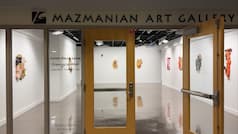
'Drawing in HMart" Solo Exhibition by Cathy Della Lucia at Framingham State University
Cathy Della Lucia's solo exhibition "Drawing in HMart" opened this week at the Mazmanian Gallery at Framingham State University. The opening reception will be held next Wednesday, September 11 at 4:30PM with an artist talk to follow at 5:30PM. All are welcome.
The show runs through October 25. Open hours are M-F 10-6PM at the McCarthy Center - 93 State St. Framingham, MA- 3rd floor. (The third floor is the main floor when you enter from State St).
%20(1).jpg)
Did Auguste Rodin Steal From Camille Claudel?
What went so wrong that the brilliant sculptor’s work became so little known? Simply put, she entered Rodin’s studio. Read Mary Sherman's article in full at Hyperallergic.
Show More.jpg)
Stephanie Stigliano's Now and Then at Bromer Gallery
At Bromer Gallery we are delighted to announce our latest exhibition, “Stephanie Stigliano: Now and Then.” The show serves simultaneously as a retrospective view of a long career of artistic exploration, and as a showcase of current activity and experimentation. Stigliano’s deft play with material and structure imbues a sense of continuity between her flat work on the walls and her artist’s books, which in their complex folds and structures demonstrate the progression between single sheet to bound volume. To unfurl the origami-like puzzle of one of Stigliano’s volumes is to collaborate in the book’s construction, to build it up again and again out of its parts. Collaboration and community inform two of the exhibit’s largest book projects, “At the Edge of the Ocean” and “Four Women for Freedom,” which both adopt sculptural formats, each building a literal scaffold around concepts that can seem nebulous, difficult, or elusive.
Stephanie Stigliano’s work is held at Harvard University, the Museum of Fine Arts, and the National Museum for Women in the Arts, and she has participated in exhibits as local as Yarmouth and Florence, Massachusetts, and as global as Iceland and Poland. She is a professor at Boston College, where she teaches, “Making Prints/Making Books.” She is a longtime member of The Boston Printmakers and is a co-founder of New England Book Artists.
“Stephanie Stigliano: Now and Then” will be on exhibit at Bromer Booksellers & Gallery from June 27 to November 15, 2024, with books and prints available for sale.
Show More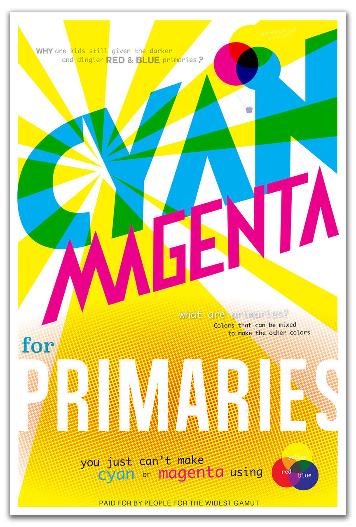
Brian Reeves Featured in Poster Show
Brian Reeves' work will be featured in the Design for Good poster show at Space Gallery in Portland, Maine.
The opening is 5-8pm on Ocobert 6. The show lasts through November 15.
Show MoreGraphica Creativa Triennial 2022 Exhibition
Brian Reeves has been selected to participate in the fourthcoming Graphica Creativa Triennial 2022. The international Triennial exhibition will be on display in Jyväskylä Finland. The organizer of the exhibition is Jyväskylä Art Museum.
The theme of the 2022 Triennial is Untold Artists’ Stories and it features works by 95 international artists from 68 countries.
The triennial will be on display in Jyväskylä October 22, 2022–January 29, 2023.
Graphica Creativa Triennial has been organized in Jyväskylä since 1975. Graphica Creativa is the oldest international print exhibition in the Nordic countries and the only one regularly organised in Finland.
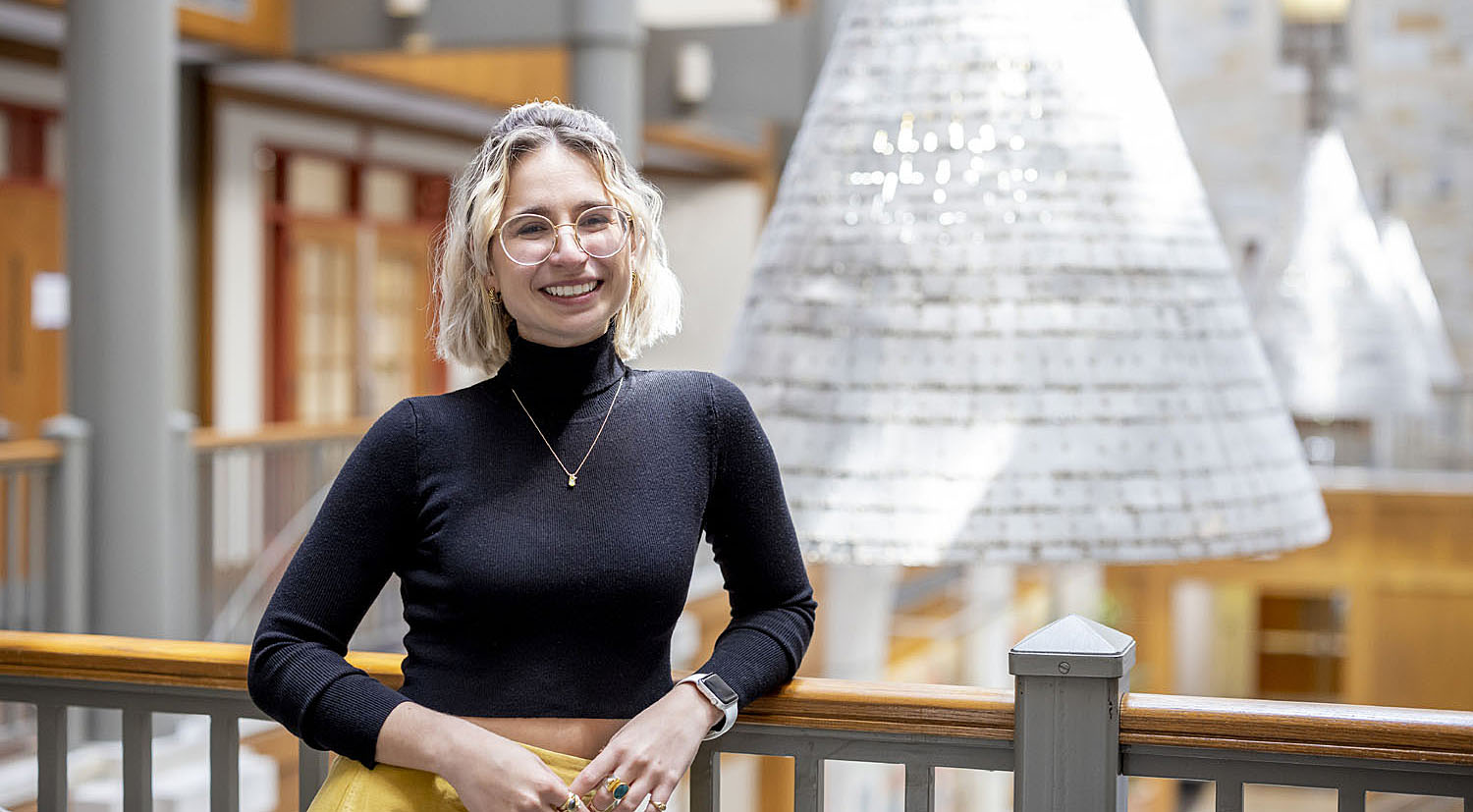
Seniors to Remember 2022: Bozhena Kulchyckyj
Bozhena Kulchyckyj has had a deep interest in entrepreneurship and venture capital. At the same time, she has pursued her passion as an artist through her studio art major. She has worked in operations roles at architectural firm Perkins Eastman and fashion startup Aurate New York, and for the past two years has served as a design lead at the technology startup Fisherman.
Read More.
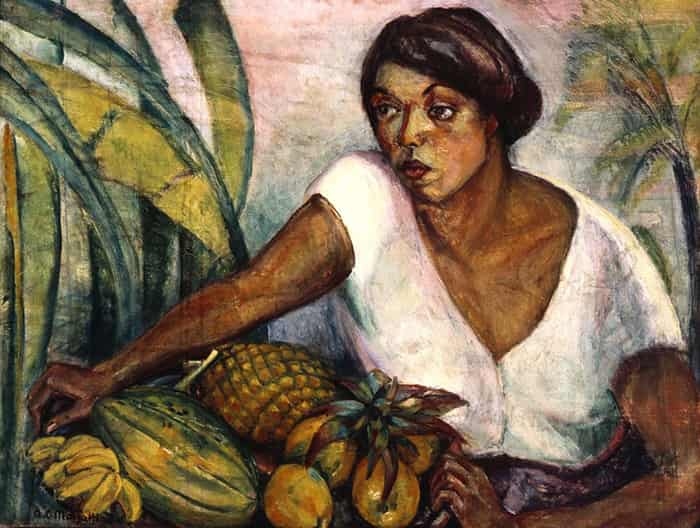
The Inaugural Art History Student Symposium
We congratulate the art history students who presented their original research in the symposium on 6 May 2022. Their topics address a range of issues (social, political, visual, and more), media (architecture, painting, photography, and more), and cultures (American, Brazilian, British, and Irish).
Christopher Rizzo - “Semana de Arte Moderna: The Birth of Brazilian Modernism”
Peyton Wilson - “Alison and Peter Smithson's Robin Hood Gardens: A Brutalist Approach to the Future of Collective Housing”
MacLaine Jones - “The Mural Medium as Political Expression During the Northern Irish Troubles”
Annie Taylor - “What’s So Funny?: Louise Lawler’s Brand of Institutional Critique”
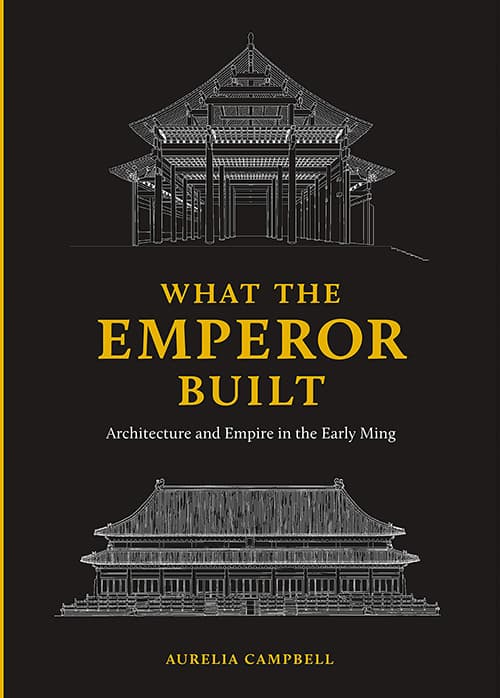
Professor Campbell's first book wins honorable mention
Professor Campbell's first book, What the Emperor Built: Architecture and Empire in the Early Ming, won the Society of Architectural Historians' Alice Davis Hitchcock Book Award honorable mention. The Alice Davis Hitchcock Book Award recognizes annually the most distinguished work of scholarship in the history of architecture published by a North American scholar. Congratulations to Professor Campbell!
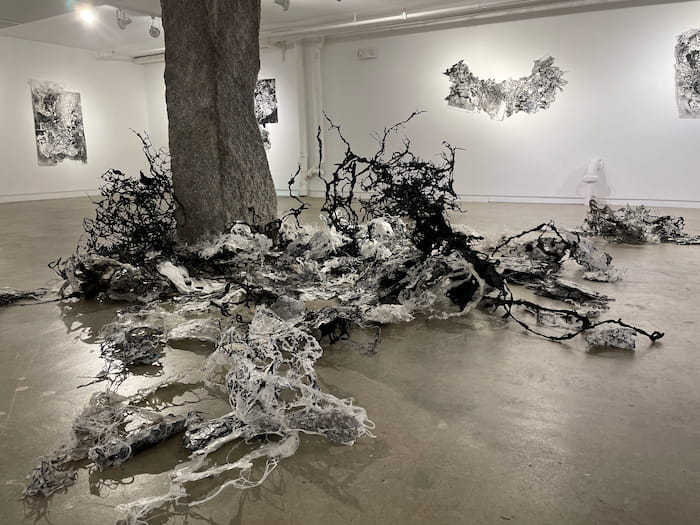
Debra Weisberg’s “Holding the Center Still”
Debra Weisberg’s “Holding the Center Still” (on view through March 27, 2022) transforms a spacious gallery into an environment of organic compositions, which look as if they have whirled out from a central installation to reach the surrounding walls. These works present a variety of ways of “making,” held together by the common thread of an obsessive impulse to experiment and explore, to push the limits of materials to encompass entirely new forms of expression.
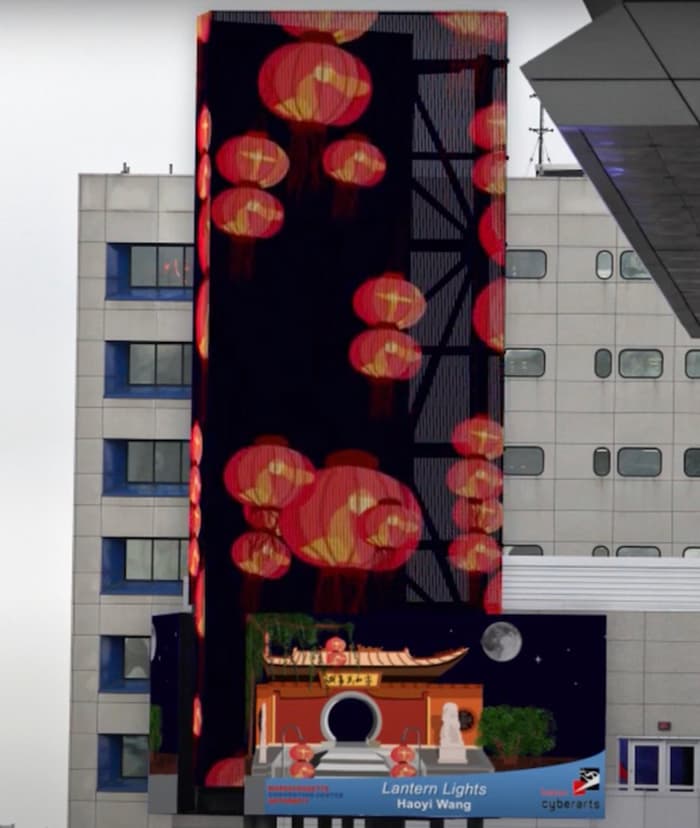
Three BC Studio Art students were selected to create moving-image public art for the 2022 Student Art on the Marquee
Graham Adamson, Runzi (Harley) Cheng, and Haoyi Wang, three students in Prof. Georgie Friedman's Advanced Digital Art: Projection and Installation class were selected to create animation and video Public Art pieces for Art on the Marquee, an 80 ft x 26 ft, seven-screen, LED marquee outside the Massachusetts Convention Center in the seaport area of Boston, MA. The call for student proposals was a part of a statewide competition, and they are three of eleven students who were selected! The pieces will be on view in rotation with the MCCA’s informational screen content starting April 26, 2022.
Graham Adamson is a junior at BC studying Communications and Studio Art. Runzi (Harley) Cheng is a junior studying film studies and economics. Haoyi Wang is a junior studying studio art and finance. Read about all the student projects here: https://www.artonthemarquee.com/student/
About Art on the Marquee: Boston Cyberarts and the Massachusetts Convention Center Authority have teamed up to create “Art on the Marquee,” an ongoing project to commission public media art for display on the new 80-foot-tall multi-screen LED marquee outside the Boston Convention & Exhibition Center in South Boston. The largest urban screen in New England, this unique digital canvas is one of the first of its kind in the U.S. to integrate art alongside commercial and informational content as part of the MCCA’s longstanding neighborhood art program. “Art on the Marquee” offers artists more than 3,000 square feet of digital display on seven screens, providing full-motion video and a viewership of more than 100,000 pedestrians and motorists. The marquee is visible for a half a mile in many directions and is seen by traffic on Summer, D, and Congress streets, as well as from the surrounding hotels, office buildings and the Seaport World Trade Center.
Show More Read More
Mixed-Media Installation By BC Profesor Explores Healing And Joy
Rarely do artists have the courage to break the static pattern of a traditional art gallery, but such is not the case for professor and multimedia artist Mark Cooper. It is no easy feat to organically weave together wood sculptures, ceramic pieces, rice paper collages, tapestries, video art and multi-layered paintings into one installation in a way that doesn’t look chaotic. However, it looks that way when Cooper is behind the process. His newest exhibit, titled “Unbounded: Angels in the Nursery,” took five days to install leading up to its opening night on February 26 at the gallery Howl! happening in New York City.
For more information, see the article in the Gavel.
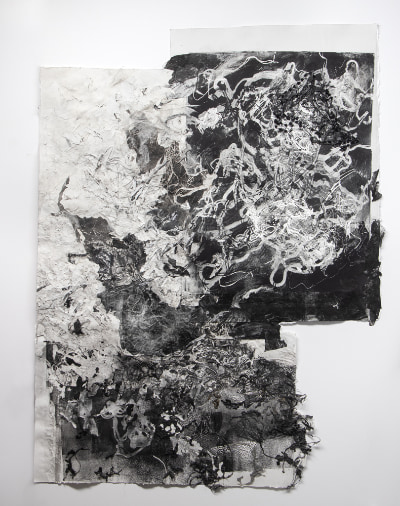
“Holding the Center Still” at Piano Craft Gallery
The work of Debra Weisberg will be featured in a new exhibit, Holding the Center Still, at the Piano Craft Gallery in Boston from March 4 – March 27, 2022. The exhibit comprises collaged paper works and a large scale floor installation. In the opening and closing receptions Vermont choreographer, Paula Higa, will premier a short piece created in response to Weisberg’s work.
In 2020, Weisberg explored printmaking (primarily monoprinting and embossing) as a Denbo Fellow at the Pyramid Atlantic Art Center. Deconstructed elements from prior sculptural installations--rope, netting, hot glue matrices--were inked and run through the press to create a large repository of deeply embossed printed images. Upon returning to her studio, these printed images were repurposed and reinvented: layered with black hot glue and handmade paper, drawn onto and into with graphite and charcoal.
The result is a richly dense body of work on paper that touches into the profound relationship between collapse and renewal. Their materiality connects touch/hapticity with the visual/optical. The work exposes the highly vulnerable nature of paper as a transparent and fragile medium that is also surprisingly enduring and sturdy.
There will be a panel discussion on expanded drawing practices on Tuesday, March 15 at 6:30. On the panel will be Audrey Goldstein, Michelle Samour and Julia Shepley moderated by Deborah Disston, director of SNHU McIninch Museum.
Show More.jpg)
Students Debate Controversial Monuments in New Art History Course
As the United States reexamines monuments with ties to racism and injustice, Boston College students have been using the methods of art history to determine possible paths forward. In Professor Oliver Wunsch's new art history course "Contested Monuments," students this spring examined the long history of controversial monuments through weekly case studies that ranged from fascist architecture in Europe to apartheid monuments in South Africa. For their final projects, each student focused on a monument of their choice, using historical and visual evidence to propose a plan for the monument's future. Read more about the course in the recent issue of Boston College Magazine.
.jpg)
Working Together: A Conversation With Mark Cooper
Studio Art Professor, Mark Cooper, was recently featured in Sculpture, A Publication of the International Sculpture Center. B. Amore, who interviewed him, says, “Mark Cooper’s sculptures seem particularly suited to the uncertain nature of our times. Like the poet Rainer Maria Rilke, Cooper “liv[es] the question” through his work, both personal and collaborative, creating visual forms that bear traces of a rich, compelling, infinitely productive, and changeable process. The pieces, which exude energy, present variations on archaic forms and seem timeless. When combined to create installations, they give a sense of continually evolving life. Cooper has worked extensively in the United States, Europe, China, and Vietnam. Collaboration with communities is one of his favorite ways of creating art. He is forever exploring new ground, and he has most recently created a three-part marble “anti-monument” for the DaNang Museum of Fine Art in Vietnam. Through this and other works, Cooper shows us that though a form may seem fixed, its associations create endless permutations in the viewer’s experience.”

BC Thesis Films Are Now ONLINE!
Students in this year’s Filmmaking III class, taught by Professor Gautam Chopra, have produced seven powerful short films, all of which are, as he says, “imaginative, diverse, and challenging.” Professor Chopra notes, “Under the best of circumstances, making a film can be arduous, unpredictable and exhausting. This year's Film Studies Majors accepted the challenge to not only produce their own thesis films, but to work within the Covid restrictions we've all had to adapt to. These production obstacles inspired creative solutions and a collection of wonderful films. Enjoy!"
Photo: Screenshot from "A Proper Goodbye," written and directed by Dejah Roberson-Cosby '21
Show More
Art, Art History and Film Department Celebrates Graduates' Achievements
On Sunday, May 23, 2012, the Art Department hosted a virtual graduation and award ceremony to recognize the 2021 graduates, and to salute those seniors who merited awards and honors.
Professor Stephanie Leone, Art History Professor and Department Chair, congratulates this year’s graduating senior award and honors recipients:
“We enthusiastically congratulate you, the Class of 2021 Art, Art History and Film Majors and Minors! Your college career took an unexpected turn when the pandemic hit, but you have responded with creativity, compassion, courage, determination, inquisitiveness, and resilience. Learning and creating in community with you has strengthened us all. We applaud you for your intellectual, creative and personal achievements during your entire career at Boston College and celebrate this auspicious moment with you. We recognize our Seniors who are receiving departmental awards and honors, and the Studio Art Majors and Minors who are participating in the annual Senior Art Exhibition. We will miss you. Please stay in touch!”
Image Caption: Dieudonne Rouanez (1920–), Country Dancers, 1967, oil on canvas, 15.275 x 23.3 in., McMullen Museum of Art, Boston College, Gift of Dr. Arthur M. Morrissey, 1999.68
Show More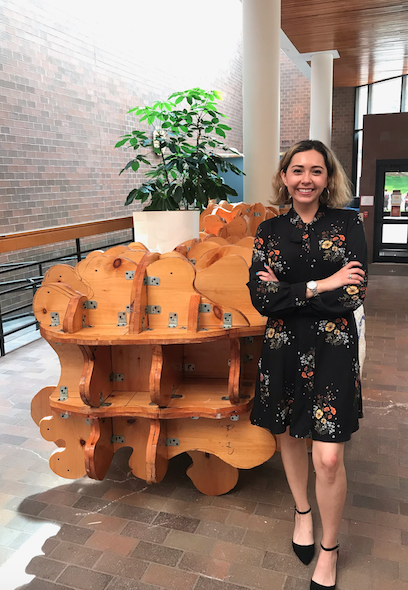
Spring 2021 R & D Ceramics Installation
In the recent Center Stage Ceramic Exhibition, featured at the annual Arts Fest on May 1 and shown in Robsham Theater, all of the pieces were created by students in Studio Arts Professor Mark Cooper's ceramics classes. Each student completed research that guided their artistic design, thus the title, R&D Art Installation, with the overarching theme "Books move us. Art brings us together!"
Robyn Beatty (Lynch School ’21), coordinator of the exhibit, noted, “Coordinating the first ceramic exhibition in the twenty-three-year history of the Art Fest was quite a remarkable achievement. This installation expanded students' creativity and expression … and, what I enjoyed most was the integration of literacy with the arts. The first R&D Art Installation, held in the O'Neill Library in the fall of 2019, had multiple pieces of literature to accompany the collection of ceramic pieces. … Having this exhibition featured in the Robsham Theater has symbolic meaning to me, as it resonates with my pursuit of a double degree in Theater and Elementary Education … and has unlocked the potential of someday being an art exhibitionist who integrates literacy and art, and hopefully sharing this with local schools down the line. … In all, this has been a joyous experience and an opportunity to display the Center Stage Ceramic Exhibition for all to witness.”
Robyn was also interviewed about the installation by Yifan Wang ’22.
Show More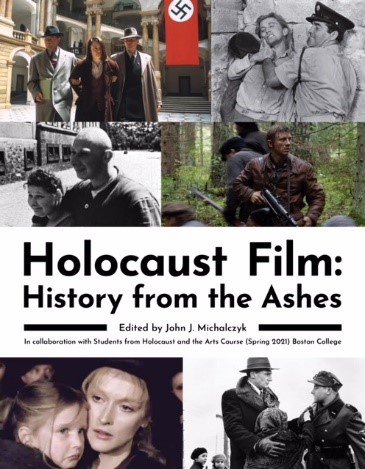
Film Studies Celebrates 20th Anniversary of the Jacques Salmanowitz Program for Moral Courage in Documentary Film
The Jacques Salmanowitz Program for Moral Courage in Film is devoted to encouraging the production of film concerned with acts of moral courage, providing role models for youth worldwide. Since 2001 students have produced more than sixty films on issues of human rights and social justice.
The program serves as a resource for student filmmakers who wish to create documentaries that will inspire future generations. The program is named for Jacques Salmanowitz (1884-1966), a Swiss businessman who was instrumental in bringing to safety in Switzerland individuals trapped behind German lines in World War II. The Salmanowitz Program was first established in 2001 through a five-year grant, and has been generously renewed annually thereafter.
Under the leadership of Professor John Michalczyk, Film Studies Director, these various events serve as a tribute to Jacques Salmanowitz:
The students from Professor Michalczyk’s Holocaust and the Arts course have published a 200-page book: Holocaust Film: History from the Ashes. Each student wrote an essay on the historical setting of thirty Holocaust films, presented in the order of the development of anti-Semitism leading to the Final Solution of the Jewish Question, the Holocaust.
Students in the Propaganda Film course created an exhibit at the O’Neill Library, Anti-Semitism, A Very Long Hatred. The exhibition was a collaboration of their critical analyses of posters that depicted the rise of anti-Semitism from its Christian origins to its occurrence today. Angelos Bougas, the Teaching Assistant for the course, produced a short film on the exhibit. Kate Canniff wrote a review of the exhibit for The Heights newspaper.
At the Annual Arts Festival, held on May 1, 2021, the Jacques Salmanowitz Program screened several documentaries as part of a retrospect of films produced with the social justice grant. The film program also included Angelos Bougas’s (’21) recent short film Colorblind. Jonathan Ng’s (’21) new Salmanowitz film project, Mauna Kea: A Fight for Indigenous Hawaiians’ Livelihoods, Lands and Rights was also screened.
Show More.jpg)
Film Student Angelos Bougas '21 Produces Short Film, "Colorblind"
Angelos Bougas, a Senior majoring in Film Studies, recently wrote, directed, and produced the short film, Colorblind. Says Bougas, "As a filmmaker, I have been creating various multimedia projects for the past four years. Over the summer, while millions across the United States were taking part in widespread protests to support the Black Lives Matter movement, I was with my family in Greece, unable to participate from such a distance. I wanted to find a meaningful way to show my support, and that is how I came up with the idea to create this short film, Colorblind.
The aim of the film is to highlight the systemic problem of violence against people of color and to elevate racial consciousness. I strongly believe that creativity is vital for the existence of safe spaces that promote learning and discussion on issues of race. Each post, picture, commercial and film made is a small step in the colossal task towards eradicating racism.”
Show More.jpg)
Jamie Kim '22 Awarded Corcoran Center Internship
Congratulations to Jamie Kim, Studio Art ’22, who was recently awarded a competitive Corcoran Center paid summer internship. BC’s Corcoran Center for Real Estate and Urban Action leverages multidisciplinary discussions and develops actions that foster community transformation. Interns are placed in non-profits, public agencies, and mission-driven organizations devoted to research-based approaches to complex urban problems. One of the organizations that mentors interns is Utile, the architecture and urban design firm where Studio Art adjunct faculty member Matthew Littell is a founding partner.
For more information about the Architectural Studies Concentration, please see Professor Sheila Gallagher: gallagso@bc.edu.
Show More.jpg)
Charles A. Meyer Memorial
The Art, Art History and Film Department mourns the passing of colleague and friend Charles A. Meyer (d. Dec 21, 2020). Charles taught photography and film making between 1977-2011, and quite literally helped build the department from the ground up. In our original quarters on the Newton Campus, he helped design both our darkroom and curriculum and, when the department moved to the main campus in 1993, Charles worked closely with the architects in charge of the renovation of Devlin Hall to create a state-of-the-art photo facility.
A consummate professional, Charles has an outstanding record in both film and still photography. After creating nearly twenty highly regarded independent documentaries, he worked for several years with Ken Burns, recording the sound for such films as The Civil War, Baseball, Lindbergh, and High Lonesome: The Story of Bluegrass Music. Charles also worked with Professor John Michalczyk on several of his social justice documentaries.
Charles was committed to social justice and used the power of images to help us confront the most difficult historical and social issues. An exhibit of his work displayed in 2011 in the O’Neill Library, titled Witnessing Conflict, included photographs of survivors of the violence in Kosovo and Northern Ireland, and apartheid in South Africa, The accompanying texts, which included the testimony of the survivors, are as deeply moving and inspiring as the photos.
His photographs are in the collections of the Bibliothèque Nationale, Polaroid, and many other institutions and private collections. His work has been exhibited at numerous museums and galleries, including the Addison Gallery of American Art, the McMullen Museum of Art at Boston College, the Institute of Contemporary Art in Boston, and the UNESCO Gallery in Paris.
A generous and inspiring teacher, Charles was a selfless mentor with his students, and he inspired generations of photographers. At BC, he curated noteworthy exhibitions on Edward Curtis, Aaron Siskind and the Photo League, bringing world-class photography to campus. Charles also taught at MIT, Clark University and Hampshire College, and was the Harnish Visiting Artist in Photography at Smith College.
Charles was a wonderful friend and colleague, with a terrific sense of humor. He will be missed by his fellow faculty, former students and friends. Charles is survived by his spouse of many years, Nancy J. Witting.
Websites: http://www.charlesameyer.com/
Sacred Moments from India, Photographs by Charles Meyer, 1996
Jeffery Howe, Professor Emeritus of Art History, 27 December 2020
Photo: Charlie Meyer (center) with Etoile film crew in Jerusalem.
Show More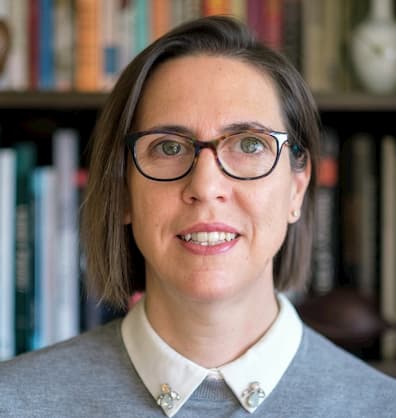
Emine Fetvaci Named Calderwood Professor in Islamic and Asian Art
The Art, Art History and Film Department is pleased to announce that Professor Emine Fetvaci has been appointed to Boston College's Norma Jean Calderwood University Professorship in Islamic and Asian Art, effective January 1, 2021. To read more about her background, experience, and outstanding accomplishments, please visit here.
Professor Stephanie Leone, Chair of the Art, Art History and Film department, noted, “We are thrilled to have Professor Emine Fetvaci join our department in the position of Calderwood Professor. An internationally recognized art historian of the early modern Islamic world, with specializations in the pictorial arts and Ottoman art and architecture, Prof. Fetvaci’s research investigates the connections among artists, works of art, and cultures across time and geography, especially the Ottomans, Timurids, Safavids, Mughals, and the Mediterranean basin. She challenges traditional conceptions of Islamic art with innovative ideas and original interpretations. We look forward to seeing Islamic art and architectural history continue to flourish at Boston College under Fetvaci’s leadership.”
Show More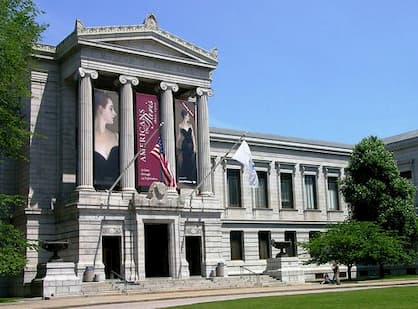
BC Professors Discuss Postponement of "Philip Guston Now" Exhibit by Boston MFA
In her December 1, 2020, article in The Heights, Metro Reporter Emily Kraus (’21) wrote about the Boston Museum of Fine Art’s postponement of the “Philip Guston Now” exhibit from this past July until 2024. The MFA directors cited recent events in the racial justice movement and the coronavirus pandemic as reasons for the delay, but confirmed their commitment to presenting Guston’s work.
In this collection of drawings and paintings, Guston (who died in 1980) depicts members of the Ku Klux Klan, who are shown as hooded figures engaged in everyday activities. The Boston MFA was one of three other institutions that have postponed the exhibit – the UK’s Tate, the National Gallery, and the MFA Houston.
Several BC Art Department professors weighed in on the postponement. Studio Art Professor Sheila Gallagher noted “I personally think the decision to postpone the exhibition for four years is cowardly, and I think it’s infantilizing for the audience of art to think they can’t tell the difference between a representation and advocacy. To me, the real fear is that museums will become places that are just these feel-good places full of flower paintings and will never confront difficult issues.”
Studio Art Professor Hartmut Austen added, “It is a sign of a very good artist, who was not sparing himself, was taking risks, and was challenging his audience. I think that’s really important.”
“Guston is an artist who explores the problems of white supremacy [and] of whiteness,” said Art History Professor Kevin Lotery. “I think that this postponement will now enter art history itself as a moment in the debate around museums. My understanding of what a museum should be is [that] these are spaces of debate, of conflict, of political conflict and debate. If they’re not that, why do we need them?”
To read the complete The Heights article, visit here.
Show More
Design Thinking for Positive Change
This past fall, Art, Art History, and Film Department Chair Stephanie C. Leone and Julia E. DeVoy, Associate Dean at the Lynch School, teamed up with faculty from three other Atlantic Coast Conference schools, Virginia Tech, North Carolina State, and Clemson, to organize a design thinking workshop. Students from the four ACC universities participated in interdisciplinary and cross-institutional teams. Their goal: to apply the methodology of design thinking to solve some of the problems facing humanity today. For more information, see the article in BC News.
.jpg)
BC Students Improve Art History on Wikipedia
This fall, students in Professor Oliver Wunsch's Nineteenth-Century Art course used their research to improve art history on Wikipedia. For the semester-long project, each student adopted a Wikipedia article related to the course that needed significant revision and expansion. Their topics included major paintings by artists such as Monet, Degas, Goya, and van Gogh. Students also addressed lesser-known subjects, such as the influential art dealer Paul Durand-Ruel. Most of their articles were no longer than a few sentences when the semester began. The twenty-five students collectively added 59,000 words and 637 citations to their articles, which have already been viewed over 37,000 times. You can find links to their finished articles here.

Prof. Mary Sherman Featured in Ely Center's Exhibit
The video of Studio Art Professor Mary Sherman’s work, Delay, is being included in "The (NotSo) Short Fest" at the Ely Center of Contemporary Art in New Haven, CT, which will be shown from December 7, 2020 – February, 2021. In addition to contributing her work, Professor Sherman also serves as an advisor to the program.
“The (NotSo) Short Fest” is a five-hour collection of video shorts created by Transart Institute’s MFA students, faculty, and advisors from around the globe. Conceived, compiled, and curated by faculty member and advisor Jean Marie Casbarian, the festival celebrates the creative minds of these international artists over the span of sixteen years, since the inception of this unique, international low-residency MFA and PHD program.
Show More.jpg)
Virtual Boston New Music Festival with Prof. Sheila Gallagher
This past November, Studio Art Professor Sheila Gallagher was the featured artist at the Boston New Music Festival, which was presented by the New Gallery Concert Series. The event included a rebroadcast of Fragility and Resilience, online concert with music videos, and a live performance by visual artist and artistic director, Professor Sheila Gallagher. Assisting with editing and production were recent BC Film and Studio alumni Ciarra Duffy ’20, Julia Hopkins ’19, and Emily Castro ’18.
The New Gallery Concert Series presents new music and visual art, as well as the composers and artists creating them. Since 2000, it has hosted over 67 concerts with over 355 musical compositions, and showcased hundreds of works by visual artists from around the world.
Show More.jpg)
Recent Publications by Art Professor Mary Sherman
Studio art Professor Mary Sherman’s book, Countess Ways, was included in the 2020 European International Book Art Biennale, Book as ®evolution, at the Károlyi Castle in Carei, Romania. The exhibition dates were September 3-20, 2020. Sherman’s book opens into a paper sculpture that can be configured to suggest multiple visual narratives.
In addition, Prof. Sherman’s article, "In Praise of Frozen Sound: Audifying Painting," was published in the journal Ikonotheka 29, Institute of Art History, University of Warsaw, 2019, pp. 21-30. ISBN 0860-5669. The editor of the journal, Zuzanna Sarnecka, says, "In this volume we focus on the role all the senses play in creating, handling, display, collecting and exhibiting art. We are indebted to the course The Sensory Renaissance, offered by the Centre for Research in the Arts, Social Sciences and Humanities (CRASH, Cambridge, 2014), and the recent studies into the importance of multisensory engagement with art and its history, including the research and publications of the Centre of Excellence for the History of Emotions funded by the Australian Research Council." Prof. Sherman notes that her article takes as a case study her multi-sensory installation Delay to demonstrate that the experience of viewing a painting engages the senses of sight, sound, and touch.
Show More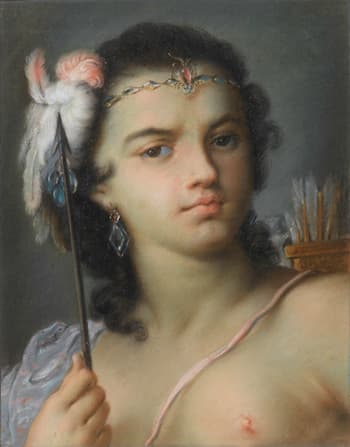
Prof. Wunsch Publishes Article on Pastel and Race in "Journal18"
Art History Professor Oliver Wunsch recently published an article in Journal18 on Rosalba Carriera's Four Continents. The article examines how and why the Venetian portraitist used the novel medium of pastel to define the skin color of allegorical figures representing Europe, Africa, Asia, and the Americas. Professor Wunsch explains how demand for novel surfaces and materials in the early eighteenth-century art market shaped the artistic construction of racial categories. He also demonstrates how artists exploited the art market’s growing emphasis on materiality to produce—and profit from—dermal distinctions not yet widespread in the broader European discourse on skin color.
.jpg)
Prof. Jane Cassidy Presents "The Thin Veil" at Pallas Projects, Co. Kerry
This past September, Pallas Projects/Studios presented Jane Cassidy—The Thin Veil—the second exhibition of their 2020/21 Artist-Initiated Projects program.
Professor Cassidy describes The Thin Veil as “an audiovisual installation that tries to capture the otherworldliness of the sea, the sand and the stars.” The film and sound were recorded while on residency at the Cill Rialaig Project in Co. Kerry. The residency is based on the side of a mountain, surrounded by the ocean, on what feels like the edge of the world. Jane says, “My friend told me as we explored a fort hidden on the side of Bolus Head that it brought to mind a Caol Áit, a narrow passage between this world and another, and I felt it.”
The film's slow and magnetic rhythm mimics deep breathing, lighting the room up and bringing it down to darkness. This installation presents a mesmerizing earthly cosmos through the infinite complexities of sand and water, where looking to the minute in the sea draws attention to the immensity of looking up to the stars. In conjunction with the exhibition, Cassidy facilitated a deep breathing workshop with a trained practitioner to develop ideas explored in the installation.
Jane Cassidy is a multi-disciplinary artist and educator from Galway, Ireland. Trained in music and visual art, Jane earned a Masters in Music and Media Technologies from TCD in 2008 and an MFA in Digital Art from Tulane University in New Orleans in 2014. Jane’s main interests lie in immersive audio-visual environments, visual music, and synesthesia. Cassidy has had solo shows at the Mobile Museum of Art, the Montgomery Museum of Fine Arts, the University of New Orleans, and the Ann Arbor Film Festival. Exhibitions include the European Media Art Festival, Germany, the New Orleans Film Festival, Punto Y Raya Festival, Spain, Currents New Media Festival, New Mexico, Galway International Arts Festival, live visuals for Animal Collective and Nanu Nanu, as well as group shows internationally. Currently, Jane is the Assistant Professor of Digital Media at Boston College. www.janecassidy.net
Show More
Art History Prof. Stephanie Leone Co-Authors Article in "Renaissance Quarterly"
Professors Stephanie C. Leone and Paul A. Vierthaler collaborated on the recently published article “Innocent X Pamphilj’s Architectural Network in Rome,” in Renaissance Quarterly 73.3 (2020): 897-952. As the abstract states: This study employs network analysis and microhistory to challenge the standard narrative about architecture and patronage in Baroque Rome, that of celebrity patron-artist relationships. It investigates the artists and artisans working with this elite team, and the plurality of relationships that developed among them. The subject is Innocent X Pamphilj’s monumental works of art and architecture, now located at the Vatican, Piazza Navona, Campidoglio, Lateran, and Janiculum Hill. The works had been commissioned for the 1650 Holy Year. The authors argue that competent artisans - and their relationships - influenced the operation of building sites, and they present Innocent X as the patron of an industrious architectural enterprise. Visit here to view the complete article.
The image shows the network of artisans in Innocent X’s architectural projects.
Show More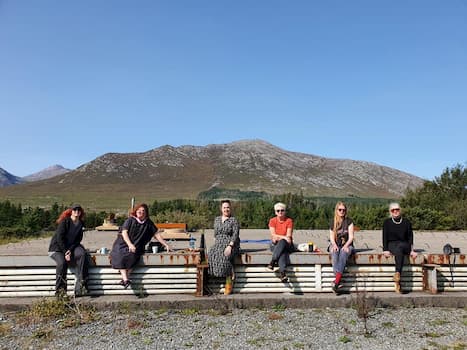
"Connect" at Interface Inagh, Galway
Connect – a group show of regional artists from the west of Ireland – took place from September 17 to October 4, 2020. Studio Art Assistant Professor, Jane Cassidy, collaborated with ten regional artists who have been creating community and meeting online every week since March. The exhibition was at the Interface Artist Residency in the Inagh Valley in Connemara, Co. Galway. Interface is situated in a remote rural location sitting above Derryclare Lough within a mountainous valley. The residency was formerly used as a salmon hatchery that was built for 40 million Irish pounds in the 1980s but failed due to engineering oversights. The hatchery is now a spectacular playground for member artists to create new work at the intersection of science and art, and to bring contemporary art into a rural community. Professor Cassidy took over the old Egg Room, a 1,000-square-foot warehouse, to install an immersive audiovisual installation that engulfed the room, floor to ceiling, in sound and moving light.
Here's a link to the exhibition
Show More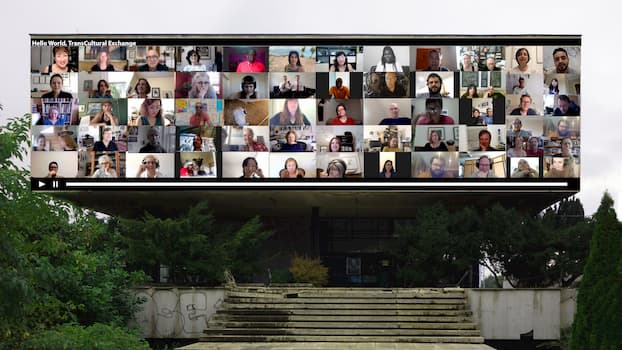
Hello World Global Art Projection on the Facade of the History Museum of Bosnia & Herzegovina, Sarajevo
Hello World – launched this past June as a large-scale international art project produced by the nonprofit TransCultural Exchange - is a demonstration of solidarity during the COVID-19 pandemic. On October 10, the public can view the project’s zoom launch, projected onto the façade of Sarajevo’s History Museum of Bosnia and Herzegovina, including greetings from the Hello World artists working in Europe, Africa, Asia, the Americas and Australia, along with their highly diverse visual artworks, music, videos and dance pieces.
Why? Faced with the COVID-19 crisis, the need for social distancing, travel restrictions and reduced contact with others, TransCultural Exchange grew concerned about the isolation, loss and fear resulting from the pandemic’s decrease in our usual sources of solace – connecting with others, the arts and exchanges of all kinds. For more information, please contact the Director of the TransCultural Exchange, Art Professor Mary Sherman, or visit
Show More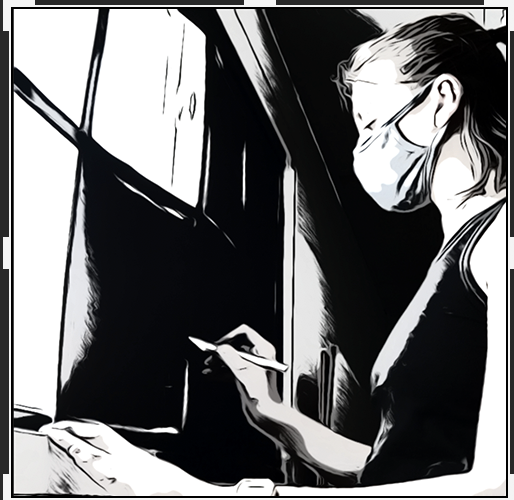
Prof. Sheila Gallagher Featured in New Gallery Concert Series: "Fragility & Resilience"
Studio Art Professor and Multidisciplinary Artist, Sheila Gallagher, created the visuals for the online New Gallery Concert Series, “Fragility and Resilience,” which took place on September 12. Gallagher describes the series as “a program of music and poetry resonating in the intensity, grief, and possibility of this moment.” Recent BC MCAS grads Julia Hopkins (’19) and Ciara Duffy (’20) assisted with the editing; Emily Castro (’18) and the Studio Art digital lab monitor, Bozhena Kulchyckyj (’22) are featured in dazzling cameos.
Part of the proceeds from the concert will go to organizations that raise awareness around the issues of violence against the Black trans population. To learn more about the program and other events at New Gallery, visit here.
Show More.jpg)
Studio Art Professor Caleb Cole's Collaboration with Burns Library
“Draft two symbolic tarot cards, one a recognizable self-portrait, and the other a design of your choosing.” Like many assignments this past spring, this assignment from the Introduction to Digital Art course had to be translated from an in-person to an online teaching format. Even though the format changed, the class goal – using a computer to develop technical, conceptual, and aesthetic images – remained the same. Studio Art Professor, Caleb Cole, as well as the Burns Teaching Librarians, stepped up to the challenge by collaborating together to enable students to meet this goal.
In addition to Cole, Nina Bogdanovsky, Senior Research Librarian / Art & Architecture Bibliographer, and Burns Teaching Librarians Kathleen Monahan and Katherine Fox worked together to create a plan for the newly formatted class so that students could “come through with creative and carefully thought-out artwork,” said Cole, and their work showed that “they definitely got it, for this assignment and for the rest of the course.”
The Burns Library Instruction Program, through collaboration with faculty and other community members, supports intellectual inquiry and scholarship through an active engagement with primary and historical resources, in both original format and digital. Please read more about the library’s materials for teaching and research here.
NOTE: The image was created by Sean Ahearn, class of ‘23
Show More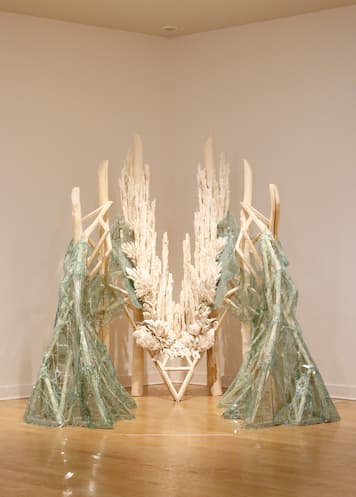
Art Professor Candice Ivy's Installation at Fitchburg Art Museum
Professor Candice Ivy’s exhibition, “After Spiritualism; Loss and Transcendence in Contemporary Art,” is currently at the Fitchburg Art Museum through September 6. Linda Crossman, Curator of the group exhibit, describes it as “an occasion to reflect on personal and shared losses through varied contemporary art practices. The works on view materialize trauma and mourning, at times confronting historical conflicts and seeking to overcome long-standing divisions. The exhibition is inspired by Spiritualism’s aim to connect the living with the dead for comfort, guidance, and enlightenment.
Spiritualism is a science, religion, and philosophy that developed in the United States in the mid-nineteenth century and grew in popularity through the early twentieth century. The movement was initially defined by its aspirations for reform, as it advocated for women’s rights and suffrage, abolitionism, and democratic access to a spiritual realm. Spiritualism spread nationally and internationally. It has a rich history in New England, parts of which will be explored in a section of ephemera and artworks in the Learning Lounge that will accompany the exhibition. Espiritismo (which, while distinct from Spiritualism, shares some common features, including ties to reform and spirit communication) will also be explored through the work of some artists.
While only a few of the participating artists practice Spiritualism or Espiritismo, they all explore broader, interconnected themes such as the impact of history on the present, transgression and agency through ritual, and the experience and residue of loss.” More information about the exhibit, organized by Curator Lisa Crossman with Terrana Curatorial Fellow Marjorie Rawle, is available here.
Professor Ivy was also recently interviewed at the museum by Assistant Curator, Marjorie Rawles, about her work there, entitled Hummm. In this brief, twenty-minute interview, Ivy talks about her creative process, materials, and themes of transformation and the feminine. As Ivy says, “Hummm—a word that elicits sound and somatic reverberation—brings together three physical materials: clay, wood, and glass. Two more key, and often overlooked materials are also present: the body of the viewer and the impact of this moment in time. These five elements combine to produce an alchemy of sorts, and a type of resonance that is at once transformative and elemental.
Using the tactile language of the natural world, Hummm is a kind of embodied force of the ecofeminine. She is a shapeshifter, eluding and transient, who holds the viewer between the dichotomies of hard and soft, strong and gentle, and cycles of creation and destruction.
Hummm draws on the felt state where these forces unfold and activate. She opens herself physically and visually around the viewer, giving an embrace that holds the potential for something new to emerge.” Visit here for the full interview.
Show More.jpg)
Article on Professor Campbell's New Book in the South China Morning Post
This past July, an article on professor Aurelia Campbell’s new book, What the Emperor Built: Architecture and Empire in the Early Ming (University of Washington Press, 2020), was published in the Hong Kong newspaper South China Morning Post.
The article focuses on the construction of the imperial palaces, now known as the Forbidden City, in Beijing, which are examined in the first two chapters of Campbell’s book. The palaces were established in 1420—exactly 600 years ago—under the patronage of the Yongle emperor (r. 1402–24), one of the most famous rulers in Chinese history. Campbell takes a fresh approach to the history of this site, focusing on often overlooked issues, such as the sourcing of materials and the organization of craftsmen. The article’s author writes that the book will “make even those familiar with Beijing’s ancient buildings feel that while they may have looked, they perhaps did not entirely see.”
Campbell will teach a seminar, “Art and Architecture in the Forbidden City,” on this topic in spring 2021.
Show More
Film Students Receive Best in Show Award for "Saving Faith"
In 2016, when Father Douglas Al-Bazi traveled to Papatoetoe, New Zealand to lead St. Addai Chaldean Catholic Church, the people there began to learn about his time as an ISIS captive. Father Al-Bazi shared his stories of torture by ISIS and his struggle to keep his faith. "Saving Faith" – written and directed by John Mohler (’21) and Luke Layden (’20) – reveals the perseverance of Father Al-Bazi and the Iraqi community following one of the most hostile times in Iraq's history.
The film was funded by the Salmanowitz and LaMattina grants, and speaks to BC’s commitment to social justice and human rights filmmaking. The Salmanowitz and LaMattina grants were postponed for the summer due to the health crisis, but hopefully will resume in January or March, 2021.
Show More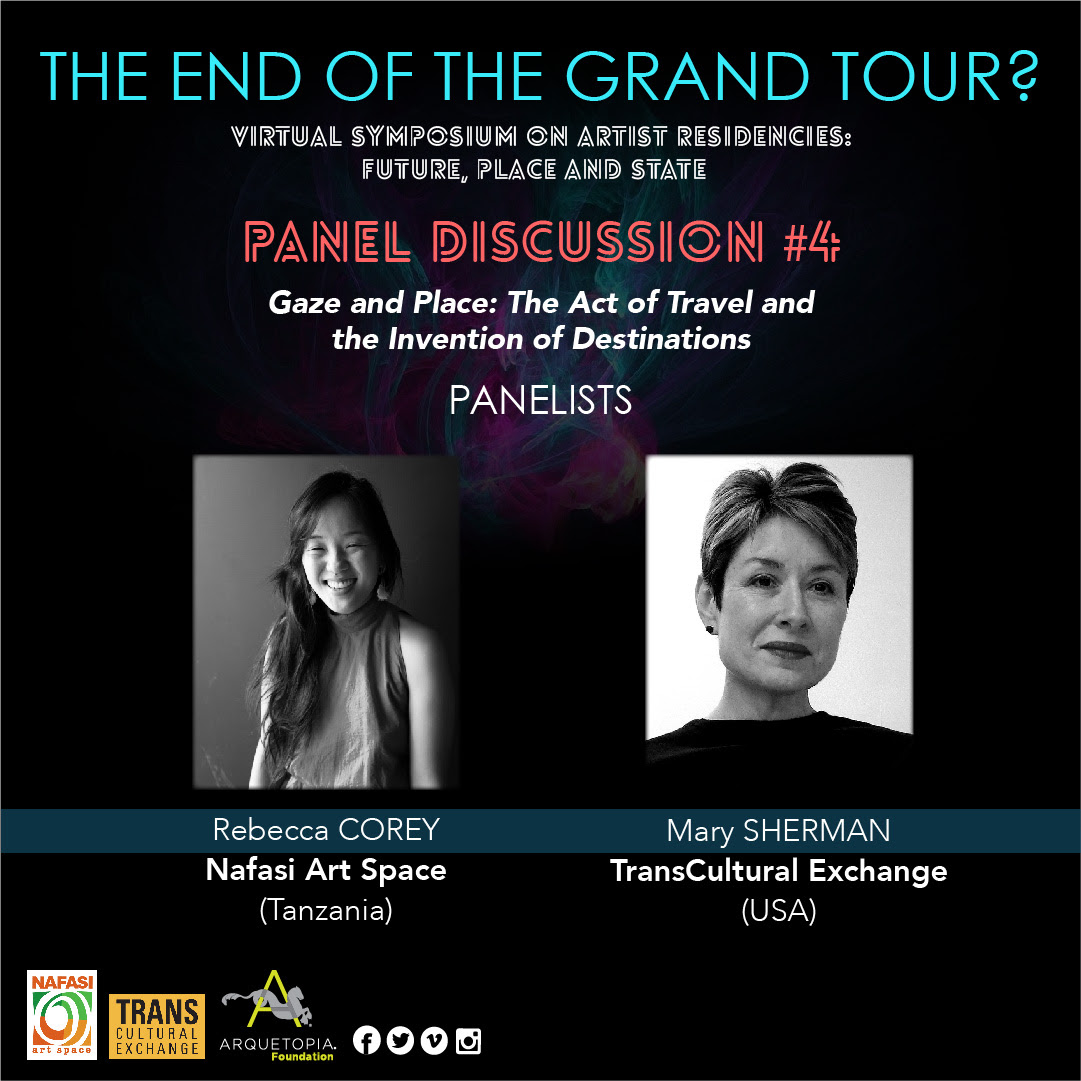
Virtual Symposium with Arts Professor Mary Sherman
Arts Professor Mary Sherman participated in the Virtual Symposium The End of the Grand Tour? Artist Residencies: Future, Place and State, produced by the Mexican based Arquetopia Foundation. The symposium took place simultaneously in eighteen different countries in collaboration with multiple institutions around the globe, from June 3 to July 28, focusing on the critical dialogue regarding the subject of artist residencies. Professor Sherman was a speaker on the panel, Gaze and Place: The Act of Travel and the Invention of Destinations, which took place July 8th. The panel addressed “What happens when an artist engages with artistic processes while immersed in a community where its culture, people, and even the place itself have been imagined and reimagined by art history and, in general, the dominant visual culture?” The full symposium may be viewed here
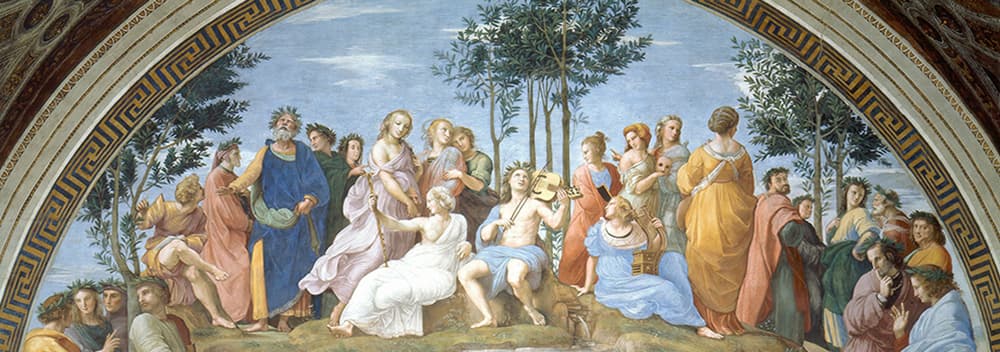
Spring 2020 Student Awards
Heartiest congratulations to our Class of 2020 Art, Art History and Film Majors and Minors! We celebrate your inquisitiveness, creativity, commitment, and hard work, which shined especially bright during this last semester. We applaud you and crown you with laurel for your intellectual, creative and personal achievements at Boston College. We also recognize our Seniors who are receiving departmental awards and honors and the Studio Art Majors and Minors who are participating in the virtual Senior Art Exhibition.
Spring 2020 Student Awards.

Mary A. Armstrong (1948 - 2020), In Memoriam
The Art, Art History and Film Department mourns the loss of beloved painting professor, Mary A. Armstrong, who from 1989 to 2018 educated and inspired Boston College students. Mary had the gift of teaching. Her vibrant vision guided her students in achieving their creative potential. Her students’ luminous and evocative landscapes hanging in the hallway brightened our department and lives.
An ardent and accomplished painter, Mary Armstrong focused on landscapes and seascapes, finding inspiration in such diverse environments as coastal Maine, the Californian desert, and aquatic Venice. Like the Venetian painters she admired, Mary’s primary means were light, color, and brushstroke. Combining paint with wax, she harnessed these forms to probe deeply into seeing and to represent real and imagined forces of nature. Mary received her BFA at Boston University, her M.Ed. at Lesley College, and attended Skowhegan School of Painting and Sculpture. Mary was recognized with regular solo exhibitions in Boston and New York as well as group shows throughout the United States, and her work is represented in many private collections. Last year, the department and the McMullen Museum of Art celebrated her recent work in a solo exhibition at the McMullen Museum.
Along with her brilliance in teaching and painting, Mary Armstrong will be remembered for her beautiful character. Her kindness, grace, ease, warmth, sincerity, and curiosity endeared her to us, her colleagues, friends and students. Knowing her was a privilege. Though impossible to capture all that Mary meant to us, this collection of quotations is a start:
Mary was a “breath of fresh air” and “she loved her students!” To her students, she was “supportive” and “inspiring.” “Few faculty appeared…[for an Honors student submitting her paintings as a thesis] but Mary wished to offer her encouragement to the student.” (John, Susan and John Michalczyk)
“Before I met her formally, I remember seeing Mary in the hallway of the fourth floor of Devlin and thinking she was one of the coolest women I have ever seen. She would often be hanging her students’ intimate paintings of the forest scenes and other landscapes…. I realized that she must be an excellent teacher to get that quality of work from her students.” (Aurelia Campbell)
“…her passion and generosity helped her students master technical issues and awakened them to new ways of seeing. I can’t begin to count the number of students who told me that she changed their lives, opening their eyes to the majesty of nature and the power of art and helping them to find their own inner strength. Her magnificent paintings were so luminous and inspiring. I looked forward to every chance to see them either at BC or in noted galleries. A rare visit to her studio was to enter an enchanted world.” (Jeffery Howe)
“Apples. I remember Mary's love for apples that she collected during our retreat (besides love for her students)…” (Hartmut Austen)
“I made several wonderful visits to her luminous studio overlooking the trees and hillside of Newton where we had some amazing conversations about art, Venice, and Italy in general. I was only at the start of a special friendship with this beautiful, talented lady. I admired her paintings of the sea and the desert and how they captured the beauty and complexity of both.” (Diana Larsen)
“As private a person as she was, she was a gabber. We talked about everything but mostly art, studio process, students, education. She was so thoughtful, so intelligent and empathetic.” (Debra Weisberg)
“Mary had an abundance of grace, and fortunately she was able to bestow a bit of that on all of us who knew her. Thus, she will live on in our hearts, memories, and, I hope, our actions.” (Andrea Frank)
“Mary was always so kind and a pleasure to work with every day.” (Linda Dietrich)
“Mary was one of the bright lights in our department; upbeat, always smiling that great big smile of hers. Inevitably, to be around her was to have one's spirits lifted. She was sincere, supportive in a way that seemed effortless, with an almost casually modest manner that, upon first meeting her might belie what a fiercely amazing talent she was…We are left with her legacy: the incredible work she made, and the mark she left on the hundreds she taught.” (Karl Baden)
“Mary and I often talked about Venice. Mary knew the city and its art inside and out, and her joy for this vibrant visual environment was infectious. When I read her notebooks on display at the McMullen Museum, I came across this insertion into her detailed description of viewing art on the island of Torcello: e dopo andiamo a prendere un gelato (and after let’s go to have a gelato). To me, this seamless transition from earnest pursuit to carefree pleasure captures what was so endearing about Mary.” (Stephanie Leone)
“Mary and her husband Stoney, both amazing painters and educators and gorgeously good and inspiring human beings, helped set me on my artist path more than anyone I could say…. Once, when I was applying for graduate school, before moving to NYC, Mary visited my studio, looked at the work and turned to me with an urgency and said, ‘tell them that painting is like breathing to you.’ This was true, but it was more true of Mary than anyone I've ever known.” (Susan Breen)
“Mary introduced me to Mary Oliver. Together, with the others in our “Alienation Seminar," we had read Yeats, Blake, Stevens, Elliot as well as Montaigne, Pascal, and on and on. But the great Mary Oliver, I did not know, the poet who shows us “the wild silky part of ourselves.” I owe Mary a huge debt of gratitude for that introduction. Mary and I spent many mornings, with the others, asking…“What is the gift that I should bring to the world?” And Mary gave, most recently in the gorgeous seascapes of her beloved ocean—where one can feel the power, see the light, and immerse oneself in the energy.” (Pamela Berger)
"Mary and I shared an office for many years, if not decades. She brightened my days and always made me feel welcomed to 'the best office ever.' She was an excellent teacher, as was evident in her students' work and their love of her. I remain impressed by her own painting as well, which I feel deserves greater recognition than it had in her lifetime. I hope, over time, this will happen." (Mary Sherman)
I had wonderful conversations with Mary over many years. The topics ranged from art to music to ideas and on. She was always intensely focused on the subject discussed. The work of her students was so fine and showed the benefits of the breadth she brought to her teaching. An artist, Mary was very generous in her interest in other artists' work. I have always loved Mary's paintings. They are personal, poetic and deeply felt. (Aileen Callahan)
Show More
Spring 2020 Video Installation: "Climate Sight"
This spring, students in Professor Jane Cassidy’s Video Installation class had planned an event in April at the Waterworks Museum, located on the site of the original Chestnut Hill Reservoir. The students were to fill the cavernous space with projections and sounds - all themed around the idea of water conservation. Unfortunately, the event was cancelled and the class had to be “reinvented.” Despite their disappointment at not being able to create this ambitious, large-scale video installation, the students reconsidered their projects and changed their focus to creating “Climate Sight” videos, based on their conversations about the current climate crisis.
They conversed with their grandparents, or with someone at least a generation older than themselves, about the effects of climate change, and then followed up by talking with their peers. Their major concern is that future generations will suffer more because of what is happening, and that we need to act now.
Show More2020 Barth Award Recipient, Emma Hardy (MCAS '20)
This year’s J. Robert Barth, S.J., Award for Excellence in the Arts, given annually to a senior who has made an outstanding contribution to Boston College in the fine or performing arts, has been presented to Emma Hardy. Emma has been actively involved in the Arts Council, and has excelled in all of her Studio Art courses, earning her Honors in Studio Art. First and foremost, she credits her art professors (Jane Cassidy, Sheila Gallagher, Candice Ivy, Karl Baden, Stoney Conley and Mark Cooper) as her role models: “They are all amazing artists and I feel so lucky to have sat in their classrooms.”
The BC Arts Journal has interviewed Emma Hardy about her artistic practice and achievements, experience at BC, and more.
Show More
2020 Senior Art Exhibition
This year’s Senior Art Exhibit – representing four years of students’ dedicated study of the visual arts – is now a virtual exhibit. Professor Alston Conley notes, “The students’ artworks are snapshots of creativity into their lives, and are the result of their problem-solving skills, critical thinking, and perseverance. Students created them in their Senior Projects course, a visual thesis project for Studio Art majors and minors. These courses assist students in developing a self-driven approach of personal inquiry and methodologies in their studio art practice.”
Says Professor Hartmut Austen, “I had the pleasure to work with a group of nineteen talented students who, over the past four months, prepared their final works for their Studio Art Minor Thesis. Varied in ideas, media and expression, they are pointed snapshots into the lives of young student artists that were upended when – in light of the current pandemic – studios, tools and technical support were unavailable. Left to their own problem-solving skills, they created a remarkable variety of works of which this exhibition can only present a glimpse. I encourage you to also visit the students’ individual websites that complement this virtual exhibition.”
Show More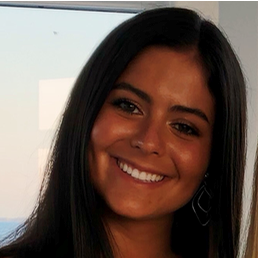
"How We See," by Ally Rooney '21
Besides taking virtual classes, MCAS Economics major Ally Rooney, reflecting on her work in Professor Mark Cooper’s Ceramics classes, has created the video production, “How We See.”
“It was quite an adjustment when we were sent home to continue classes with remote learning,” says Ally. “It was especially hard for classes in which being in person was an integral part of the class. … This is how I came up with the idea to create a video presenting all the pieces I’ve made in ceramics over the years as a final project. I learned that the presentation of the pieces is just as important as the pieces themselves.”
Professor Cooper notes, “Ally and I had discussed the importance of the presentation of art in putting ideas forward. She worked within the limitations of being away from the ceramics studio to create a terrific video that addressed the issues we discussed and surpassed them. Conceptualizing and making this video is a creative moment that will no doubt have many different manifestations in her life going forward, and one she came to completely on her own.”
The music pieces are (chronologically): Angels by Khalid, Tenerife Sea by Ed Sheeran, I Miss You (Acoustic) by Clean Bandit and Julia Michaels, How to Love (Acoustic) by Cash Cash and Sofia Reyes, Best Shot by Jimmie Allen, Close to You by Rihanna, Vertigo by Khalid, Dancing on My Own by Calum Scott, Happier by Ed Sheeran, and Dare You to Move by Switchfoot.
Show More
"Digital Art in Quarantine," Spring 2020
This semester, students in Studio Art Professor Jane Cassidy’s Print Based Media class have gone above and beyond the usual expectations by creating their own website to display their work: Print-Based Quarantine.
Although the original goal of the class was for students to make innovative laser cut and large-scale inkjet prints, this was not possible as the class moved online in March. But that did not hold these students back from their ambitions, as they virtually “reinvented” the class by making a combination of animated GIFs, a digital one-page-per-person zine, and web pages of their own.
Show More
Farewell Video From the Art, Art History, and Film Department
In this unprecedented time, and as graduating seniors are leaving BC, the Art Department faculty and staff created a farewell video to all Art, Art History and Film students - bidding them farewell, wishing them the very best as they continue on with their studies and new ventures, and looking forward to reuniting with returning students soon.
As Department Chair Stephanie Leone noted, “The best part of my job is meeting and interacting with students.”
Special thanks to Ashley Craig, Technology Coordinator, and Studio Art Professor Jane Cassidy for their work on this effort.
Show More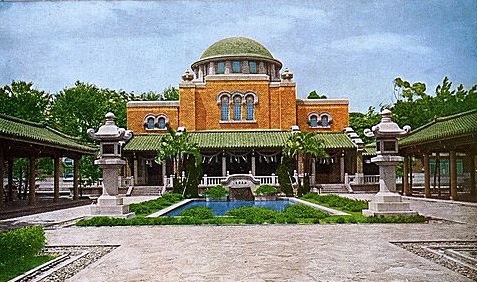
Art History Student, Rose Kuo, Publishes Paper on eScholarship
Rose Kuo, a History major and Art History minor with a focus on East Asia, recently had her paper, “Empire in a Shrine,” published on eScholarship. After taking many Art History classes with Professor Aurelia Campbell, Rose developed a strong interest in the material culture of Asian religions. When reading works of art and architecture, she pays special attention to the intersection of space, objects, and historical memories. She has incorporated these concepts in her own research of Shinto shrines in Taiwan ˗ where she hails from - that were built during the Japanese colonial period (1895-1945), looking at how imperial authority was reflected in these structures.
Building upon this paper and her academic interests, Rose is completing a Scholar of the College Thesis project in History, using her art-historical training to address the reconfiguring of Shinto shrines into Chinese loyal martyr shrines, and the different ways in which the Chinese authorities and Taiwanese people have grappled with colonial legacies. She hopes to advance this interdisciplinary approach to her future study at Columbia University’s Master’s program in Religion this coming fall.
Rose has been pursuing the Art History department's Museum Studies track. She was a recipient of the WorkArt Kunstverein Fellowship in 2018, where she interned at Künstlerhaus Stuttgart, Germany.
Her paper may be viewed on eScholarship at http://hdl.handle.net/2345/bc-ir:108733.
Show More
McMullen Museum Student Ambassadors' Art in Focus: Alen MacWeeney with Profs. Lisa Kessler & Greer Muldowney
From September 9 - December 8, 2019, the McMullen Museum Student Ambassadors' Art in Focus series featured: "Alen MacWeeney with Professors Lisa Kessler and Greer Muldowney." Kessler is Adjunct Professor of Photography and Muldowney is Assistant Professor of Photography in the Art, Art History, and Film Department. From their perspectives as both practicing photographers and photography educators engaged in the history of the field, Muldowney and Kessler discuss the street photography of Alen MacWeeney, which was exhibited at the McMullen Museum. MacWeeney is an Irish-American photographer, born in 1939, who was Richard Avedon's assistant in Paris. His photographs have appeared in celebrated magazines, such as The New Yorker, Life, Smithsonian, and American Photographer, and his work is present in many museum collections, ncluding the Museum of Modern Art, The Metropolitan Museum of Art, and the McMullen Museum of Art.
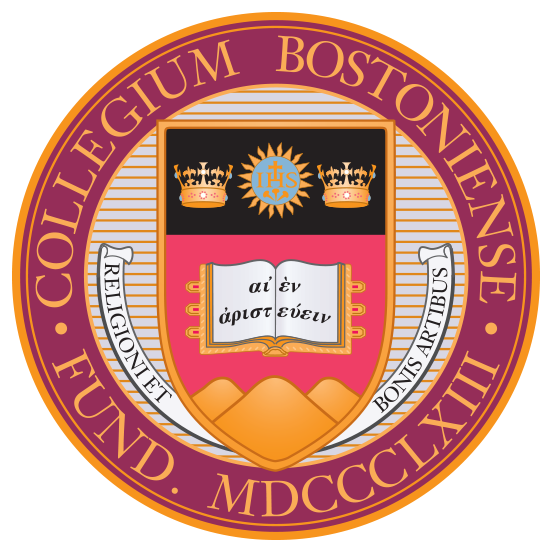
Student Scholars Receive Morrissey College of Arts & Sciences Awards
On behalf of the Art, Art History, and Film Department, Chair and Professor Stephanie Leone congratulates Art History Major Matthew DiBenedetto and Film Studies Major Anthony Kim on receiving the academic designation of Dean's Scholar of the Class of 2021. This award recognizes the brightest scholars from the Junior Class, based on "academic performance, recommendations from their departmental faculty, co-curricular activities, and their sense of purpose in how they approach the future." Also on behalf of the department, Leone congratulates Art Major Shuwen Liu, Art History Major Christopher Rizzo, and Film Studies Major Marie Eliane de Roualle on receiving the academic distinction of Sophomore Scholar of the Class of 2022. The recipients have an academic ranking within the top three percent of their class and were nominated for this award by the department.

Professor Greer Muldowney Promoted to Assistant Professor of the Practice of Photography
Professor Stephanie Leone, Chair of the Art, Art History and Film Department, recently announced the promotion of Professor Greer Muldowney to Assistant Professor of the Practice of Photography.
Greer Muldowney is an artist, photography professor and independent curator based in Boston, Massachusetts. Her work often tackles the relationship of policy making and how it affects landscape, housing and community. She received an undergraduate degree in Political Science concentrating in Urban Policy and Studio Art from Clark University, and an MFA from the Savannah College of Art and Design. She has acted as the Curator for the Desotorow Gallery in Savannah, GA, and was the Regional Coordinator for the Flash Forward Festival on behalf of the Magenta Foundation in Boston, MA. She has served on the Board of Directors for the Griffin Museum of Photography, and is the Founder and Director of Undergraduate Photography Now, an arts organization bolstering the work and professional development of photography students. She has juried and curated exhibitions nationally, and, previous to her role at BC, has taught photography at Lesley University and Boston University.
Muldowney’s photographic work has been exhibited widely. She is the recipient of the 2013 Massachusetts Cultural Council Fellowship, and a PDN 30 Photographer to watch for 2014.
Show More
Art History Professors Stephanie Leone & Alison Fleming Co-Publish Chapter on the Chapel of Francis Xavier in Rome
Professors Stephanie Leone and Alison C. Fleming (Winston-Salem State University) have co-published the chapter, “The Arm Relic as Index of the Body: The Chapel of Francis Xavier in the Gesù,” in Chapels of the Cinquecento and Seicento in the Churches of Rome: Form, Function, Meaning, eds. C. Franceschini, S.F. Ostrow, P. Tosini (Milan: Officina Libraria, 2020). Entombed in 1554 in Goa, India, where he had been a missionary, Francis Xavier’s body was incorruptible and worked miracles as proof of his sanctity. In 1614, Xavier’s arm was amputated and sent to the Church of Il Gesù in Rome to extend his cult to the principal church of the Society of Jesus. From 1672-1684, the Chapel of Francis Xavier was created for the display of the precious relic. In this chapter, Leone and Fleming present their unique analysis of the function and meaning of the chapel as an integrated spatial environment, comprising the relic, reliquary, altarpiece, fresco paintings, metalwork, architecture, and polychrome stone. They propose that the chapel can only be understood through the analysis of the individual components in relationship to one another and the whole. Centered on the arm relic, the chapel persuasively verifies and celebrates the life, sanctity, and legacy of Francis Xavier, one of the first Jesuits.
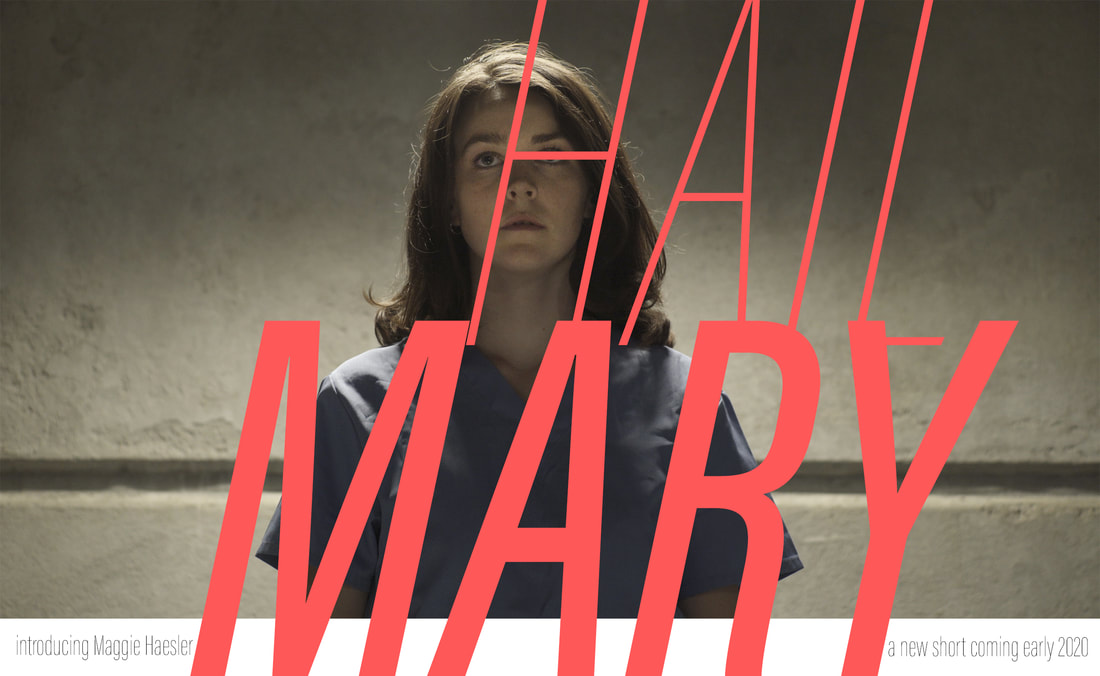
Film Department Announces Short Film, "Hail Mary"
Professor Joe LaRocca has written, directed, and produced the ten-minute short film, Hail Mary, based on the true story of a teen with cystic fibrosis who breaks out of the hospital to attend her high-school prom. Professor Gautam Chopra served as Assistant Director and co-produced the film, which features BC students Maggie Haesler (’19) as Mary, Miki Peiffer (’19) as Ben, and Hadley Durkee (’20) as Karen. The film crew also includes McKenzie Raycroft (’17), First Assistant Camera; and Ashley Brown (’20), Production Assistant/Makeup. The film will be available for viewing this spring at www.laroccafilms.com.

Aurelia Campbell, PhD, Promoted to Associate Professor of Art History with Tenure
Professor Stephanie Leone, Chair of the Art, Art History and Film Department, recently announced the tenure and promotion of Professor Aurelia Campbell to Associate Professor of Art History.
Professor Campbell is an art historian of China, with a particular focus on the Yuan and Ming dynasties (ca. 1200-1600). Her most recent research has centered on imperial architecture of the early fifteenth century. This is the subject of a number of her articles and book chapters, as well as her first book, What the Emperor Built: Architecture and Empire in the Early Ming (University of Washington Press, 2020), which focuses on the construction projects of the famous Yongle emperor. She is especially interested in the relationship between the imperial court and outlying regions and thus looks closely at the networks (craftsmen, materials, edicts, officials, precious objects, religious leaders) that connected them. She is engaged in several ongoing research projects, including an examination of imperially patronized Tibetan Buddhist stupas in Beijing. Her research has been supported through several grants and fellowships, including from the Millard Meiss Publication Fund, the James Geiss Foundation, the National Endowment for the Humanities, and the Asian Cultural Council. Since 2018 she has been involved in the creation of an English dictionary of Chinese architectural history terms in collaboration with scholars from Vanderbilt University and Southeast University in Nanjing, and during the 2016-2017 academic year she was a visiting scholar at the Max Planck Institute for the History of Science in Berlin, Germany.
Show More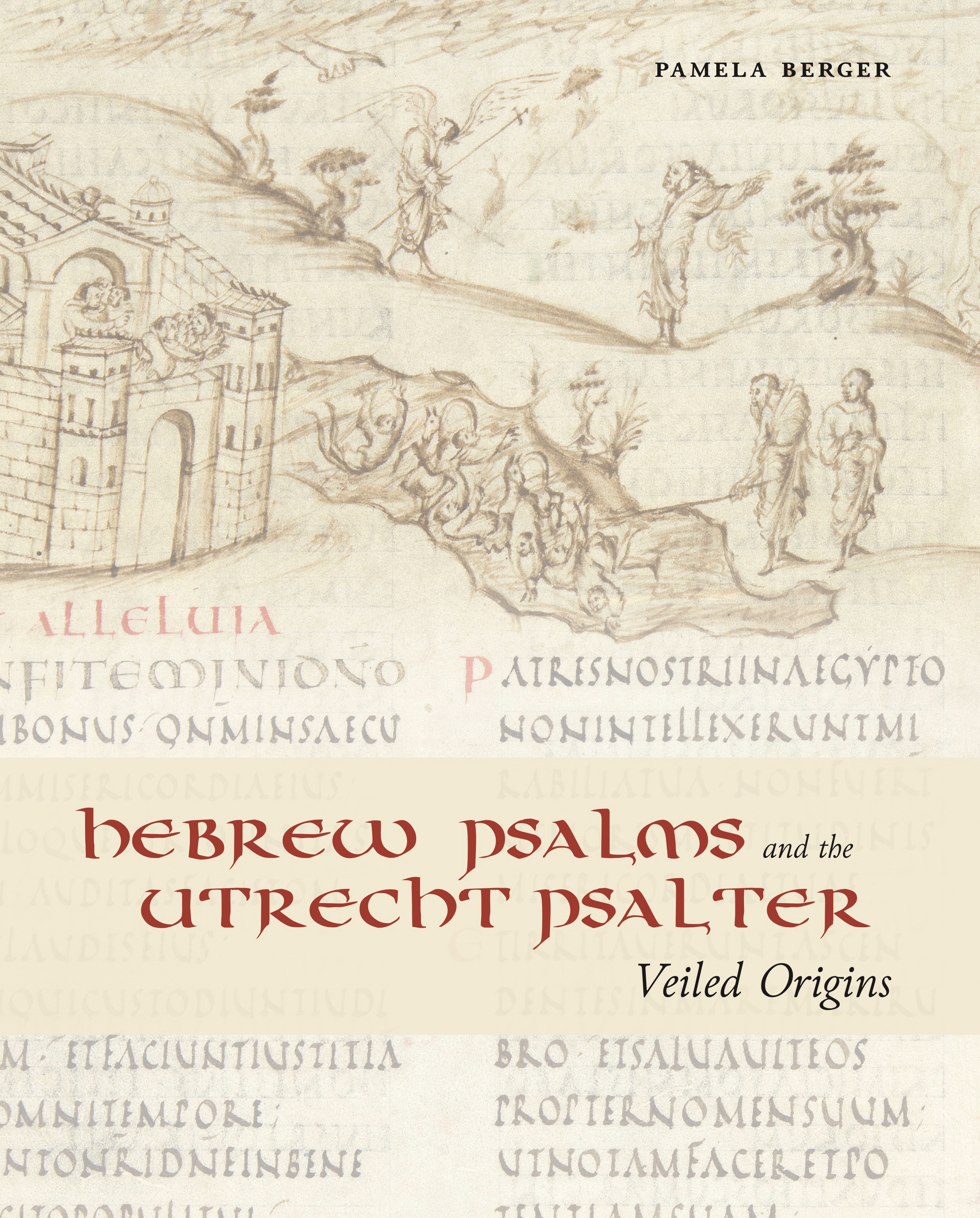
Professor Pamela Berger's New Book, "Hebrew Psalms and the Utrecht Psalter: Veiled Origins"
Penn State University Press recently announced the publication of Hebrew Psalms and the Utrecht Psalter: Veiled Origins, by Professor Pamela Berger: "In a major departure from previous scholarship, this volume argues that the illustrations in the famous and widely influential Utrecht Psalter manuscript were inspired by a late antique Hebrew version of Psalms, rather than a Latin, Christian version of the text." The motifs illustrated in the Utrecht Psalter are largely literal renditions of words and phrases in the book of Psalms. However, more than three dozen motifs cannot be explained by either the Latin text that accompanies the imagery or the commentaries of the church fathers. Berger demonstrates that these motifs can be explained only by the Hebrew text, the Jewish commentary, or Jewish art. Drawing comparisons between the style and compositions of the Psalter images, and the style and composition of late antique Galilean mosaics, Berger argues that the model for those Psalter illustrations dependent on the Hebrew text was produced in the Galilee.

